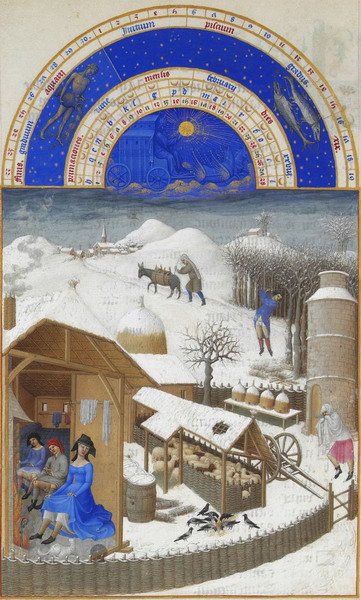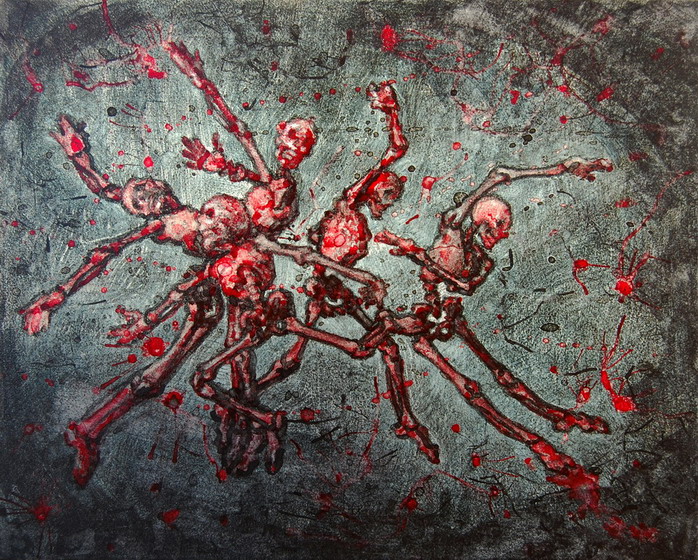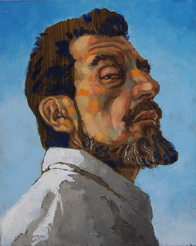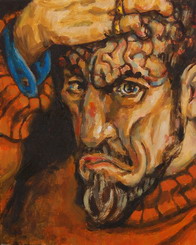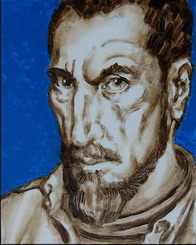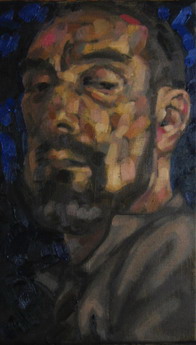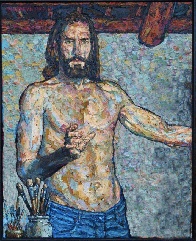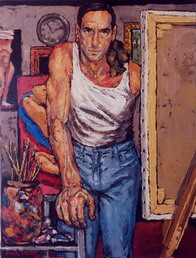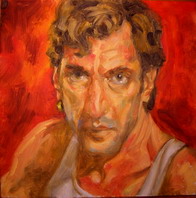Mental Workshop- pg 1 | pg 2 | pg 3 | pg 4 | pg 5 | pg 6 | pg 7 | pg 8 | pg 9 |
<previous | next>
Photos of the Spring fair in Sevilla in a new window



Why Humans prefer other Humans to be like themselves (1400 words)
Ambrose Bierce defined madness as "Affected with a high degree of
intellectual independence; at odds with the majority; in short,
unusual. It is noteworthy that persons are pronounced mad by officials
destitute of evidence that they themselves are sane."
Like all successful wit Bierce’s statement makes us laugh because
its absurdity brushes against truth. But in fact the
‘officials’ he refers to do have evidence they are sane:
they agree with each other and form a majority with the power to judge
the minority.
At the beginnings of religious orders, when a new theology sprouts, the
ones oppressed by the societies they find themselves in seldom suffer
from prejudices against their beliefs but, time and again, are
oppressed instead because of their claims the existing order is wrong.
Allah existed before the prophet Mohammed declared he was the only real
God, while the polytheistic panoply he had been member of until that
time was not.
Jesus of Nazareth was not seen as a Christian (indeed, the Christian
church didn’t begin until long after his crucifixion) by the
Roman state that had integrated Jewish beliefs along with all the
others that belonged to the countries the Empire conquered. It was only
when Jesus insisted his vision of God was the only true one, that Rome
found him worth repudiating.
A Hindu with a belief in thousands of gods, each a symbol of a
phenomenon, aspect of character, philosophical or moral ideal will
assimilate even monotheistic gods they like, as one more of the many
they already believe in (sometimes confounding missionaries into
thinking they've had miraculously easy success in their attempts at
proselytising).
While a Hindu who enters a monotheistic society like a
Christian one, is likely tolerated even if considered an infidel whose
eternal soul will be punished for its owner’s misjudgement; it is
less likely that a Protestant Christian will be abided by a Catholic
Christian (or vice versa). Why do two theological constructs that agree
on most questions threaten each other more than those that disagree
altogether?
A belief such as that in the existence of Purgatory can be put in
question by the arbitrary decision of the placement of a comma by the
New Testament’s third linguistic generation of translators (from
original texts that used no punctuation at all) and so the two versions
of: “Verily, I say unto thee, this day thou shalt be with me in
Paradise”, with the comma moved from after ‘thee’ to
after ‘day’, are interpreted by theologians as meaning
‘the day you die’ (by Protestants) and ‘a day’
by Catholics (allowing time for Purgatory). Such small differences call
into question the fundamental beliefs of either camp while a faith in
the elephant-headed God Ganesh, the remover of obstacles who rides a
Manticore through the universe, does not.
The same is true not only of what we think or believe, but also of how
we think. And here I am not thinking of Bierce’s comments on
society’s assessment of madness but of measurable, biological
differences in pure cognitive processes.
Intelligence quotient tests are more than 100 years old now and their
efficacy in measuring a variety of the brain’s processes
hasn’t been called into doubt in these last 50. But with
today’s advances in neuroscience and its ability to physically
measure the neurochemical flow and brain activity in known sectors,
corroborate beyond doubt the IQ tests’ validity and reliability.
But despite these facts the totality and relevance of the measure of
intelligence is still difficult to define and yet, each of us recognize
intellectual abilities when we see them in each other.
If intelligence is as important an element in our evolution as a
species as it seems to be, why are the giftedly intelligent often
failures in their societies? Sometimes socially awkward, sometimes less
successful in their jobs and with a higher occurence than the norm of
depression and suicide?
I am reminded of a short story by Kurt Vonnegut where a society that
seeks justice in the form of egalitarianism in competition, turn the
strong weak by making them carry a handicapped weight, turns the
graceful awkward and the smart, stupid, by the use of startling noises
through headphones that won’t let them concentrate their thoughts.
A typical interaction between a person of lower IQ with one of a higher
IQ includes the lower IQ’s recognition of the other’s
higher one, while avoiding attaching any attributable applications,
i.e. though the slower mind recognize the faster, it finds a way to
believe that in essence there aren’t any important abilities the
better brain has that its own hasn’t. An example? Any idiot in
the street including me, is ready at the drop of a hat to spout
vehement political opinions that would affect billions of people if
anyone cared to listen to them, forgetting that even the worst
politician in the world has a better grasp of the complexities of such
questions.
Unusual abilities like a facility for numerical
calculation or information storage are applauded like parlour games but
a more complex manifestation of intelligence, like grappling with the
abstract concepts of philosophy, is resisted and argued by anyone.
Sometimes there is no reasoning behind the confidence in our own
brain's workings regardless of evidence, while at others there is a
confused logic concerning such things as comparison to emotional
intelligence or intuition as an alternative form of intelligence.
Few of the less cognitively able are willing to trust
the workings of the able over their own despite recognising the
ability’s existence. An uncomfortable position to be in that
makes the mediocre mind prefer the conformity of other mediocre minds
to the threat it feels to its own ordinary abilities from the
extraordinary.
Though ugly want to be handsome it prefers making handsome ugly, to being ugly in its presence.
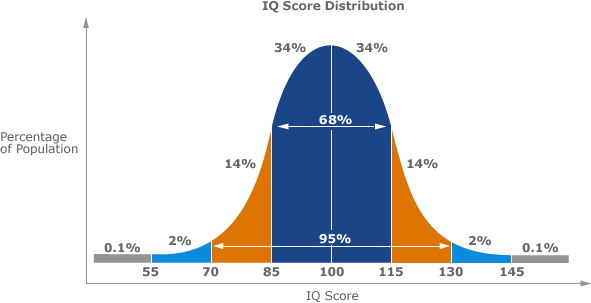
Bierce’s reference to madness is undoubtedly to the creative kind
rather than the destructive. A Paranoid Schizophrenic for instance, is
pretty clearly destructive to himself and potentially dangerous to
society whereas some important theorists like Joseph J. Schildkraut* wondered at the creative motivator a deviation from the normal range of emotions could be.
Schildkraut asked himself if while ‘curing’ the
disagreeable manic depression extreme of bipolarity with pharmacology,
was he also removing a creative impulse that belonged to the hypomanic
end? Is the bipolar’s social difficulties made up for by his
social value as maker of culture?
Dr Kay Redfield Jamison, today’s leading expert in bipolar
personality disorder, claims a historical correlation between the
bipolar personality and creativity, citing personalities from Lord
Byron to Van Gogh, as examples of those whose emotional swings and
extremes caused them certain social dysfunctionality (behaving in a
‘mad’ way in other’s eyes) as well as accounting for
the inspiration to great art.
And though some point to evidence that aside from
lethargy, depression is also accompanied by a lowering of IQ, much
great art from poetry to music or painting, is motivated by desperate
sadness that would be impossible to compose with an even temper.
As a sufferer herself (the reason for her choice of study) Jamison said
in an interview that she longed for peace and tranquillity; but in the
end, she preferred "tumultuousness coupled to iron discipline" over
leading a "stunningly boring life."
The gloom, confusion, lethargy, irritability and ire of the depressed
end of the manic state can scare, confuse or offend the person of
normal emotional range as much as he might be confused or offended by
the euphoria, confidence, the speed and intensity of thought, the
hypomanic end exhibits.
The bipolar personality that has a personal philosophy which allows it to withstand the seemingly endless sense of dejection that defines one extreme, awaits the intensity of life, its hyper-sensitivity to sensory perception, its joys and the creative inspiration of the other extreme - undreamt of by the doctor who cures the suffering with anti-depressants.
Indeed, like Ambrose Bierce, one might ask: Which is the disorder? Bipolarity? Or he who prefers the peace and ease of sticking safely to the middle while avoiding the density of the extremes?
footnote:
* Professor emeritus of psychiatry at Harvard Medical School and founding director of the Neuropsychopharmacology/Psychiatric Chemistry Laboratory at the Massachusetts Mental Health Center. Whose seminal paper: "The Catecholamine Hypothesis of Affective Disorders," published in 1965, set the agenda for biological research on depression for the next 25 years. Return
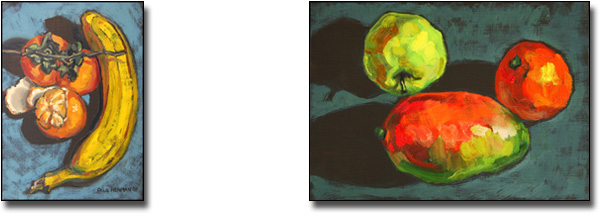
A letter to painters- How to sell paintings (2820 words)
I think the idea I propose in the letter below holds a seed that could find fertile soil. I have published it in a dozen forums & Web-sites for reactions & if I found enthusiasm or support I would be willing to disseminate the idea across the Net in a way that reached a representative number of artists not succeeding in selling their work through their personal Web-sites.
It is an idea in search of a leader & if
it turns out to be a good one I'm sure the appropriate leaders will
present themselves precisely because they qualify in that capacity.
"Art is not purity it is purification, it is not liberty it is liberation"
CLARICE LIPECTOR
Since my parents are/were painters, we never lived in one place long
& I have travelled a lot since, I think I have known more artists
& artist's communities than most (by communities I mean those
working in the same place & so, whether friends or bitter enemies,
mingle in the same art events, share models or discuss art.)
I have also seen a more rare but delightful sight: actual art
communities like one in an abandoned industrial estate taken over by
painters & sculptors outside Madrid or a coal town near Leeds where
artists will share anything from materials & opinions, to
publication or promotion costs as well as the power to attract buyers a
group of artist workshops has.
All this without mentioning the most important bit: the communal
inspiration & support that eggs each member to better work. But the
point of this letter is not about being better painters but about
selling paintings.
This familiarity has shown me many artist stereotypes are often enough
true, just as, speaking generally, one might say are of computer
programmers, scientists or athletes.
A painter’s job is a solitary one even, in a sense, when he
paints a model; the painter while painting, communes more with his
canvas than the other person in the room. This makes us introspective
& sometimes awkward in general society.
There are jealousies, arrogance, poor work ethics, backstabbing (for
instance: painters who turn up at each other's openings to sneakily
hand out their business cards to the other’s clients!) In fact
this is so common an example, that there are times a painter is trying
to charm someone else’s buyer only to discover upon offering a
business card that they are both painters at the same game!
We are an unruly, eccentric & cranky lot, the only community of its
sort: defined by the very fact the members are not like each other.
But having been among the first painters (at least here in Europe) to
embrace the Web (I still have a copy of my first Web-site somewhere-
designed in PERL which looks positively Neolithic! I also remember when
I switched from handing out business cards to CDRoms with printed
covers & those thick stickers for the disc we used to use; it was
long enough ago that people's jaws used to drop!) Since then I
have been aware of an evolution in this particular sector of the Web
which I think is reaching an important turning point.
Let’s define ‘sector’ to start, I am not talking of
the boon the Internet has been for big auction houses selling expensive
Renaissance or Impressionist work, nor either of the aid to established
brick-and-mortar galleries Web-sites & Web-promotion, has been for
them; Nor even the many virtual galleries & agents that exploit the
medium but rather the rest of the pyramid, the large base made up of
painters themselves through whose Web-sites so few paintings sell.
Let us also be honest about our Internet presence, of all the
interaction between us which I’m about to talk about, &
despite a number of the starry-eyed in search of applause or the few
among us with dreams of immortal fame, we are all on the Net for one
& the same reason: to sell our product.
There are plenty of stereotypically bitter painters who moan about
their misunderstood & underappreciated genius, but it is a far more
common & simple feeling the majority of painters share: They feel
they are involved in a vocation with an extremely long learning arc to
reach maturity, at which they work with discipline but are still not
remunerated.
Attempts at Internet art sales by painters is not a very with-it or
Web-fashionable corner of the Internet, without mentioning one that
generates little money. And since actual direct sales of paintings to
clients who find them through our personal Sites are still rare,
most painters’ Sites haven’t become sophisticated enough in
design or 'findabilty' to compare to the slick sector of say, real
estate sales which generates a great deal of money & has multiplied
its number of potential clients compared to prior to the Web.
For those who haven’t taken the years necessary to learn to
handle computers or even (like so many painter Sites out there) to
understand the Internet well enough to know what they need to make
their own Site, attractive, navigable, Internet-fashionable &
‘findable’ through search engine query (have you ever
noticed, for instance, how many artists Sites are called
‘Home’?! Or how many size their thumbnails by width instead
of height? Or use maddening horizontal scroll bars? Or 6 types of Font?
Or even many successful Sites that sell workshops or how-to-paint
videos that have no focal point- somehow these same artists who spend
their lives designing beautiful compositions forget it is important for
their screen presence also…
Or understand nothing of the psychology of colour? (specific to the Web
& evolving constantly). No keywords, no text content- how in the
world can the Google God decide if these Sites are relevant to searches
looking for paintings?)
For those painters who are Internet-innocents, instead of buying
ready-made formats or using cheesy ones that oblige you to exhibit
their advertising, or exist under an umbrella which is what the
umbrella Site’s owners really promote instead of your being able
to promote your Site independently (just as restaurants get free
decorating in exchange of painters who hope to sell to their diners)-
Or paying a Web-designer more accustomed to doing small-business
designs, we can share Web-site templates from a central Site where any
member can contribute his input (creating a pool of more options, not
choices between each other's ideas) designed by ourselves for
free.
The templates designed by those artists who handle computers will, as a
group of minds, come up with a ‘look’ that gives us
creative choices computer programmers won’t think of, while also
accomplishing something which many artists don’t realize is just
as important: homogeneity. We are so accustomed to wanting to be
original that we forget the reason the yellow pages worked so well in
the past is because of their sensible organisation. Personal art Sites
exist for the same reason as the Yellow Pages but our version is not
even in alphabetical order!
As you all know, there are a gazillion Sites, e-mails, &
‘artist representation’ of all sorts offered whose claims
to work for artists is a lie in the converse, they are opportunistic
parasites who earn their living from gullible painters who think the
exposure they buy will lead to sales- though it seldom actually does
& artists who work day-jobs to pay for it seldom see their
investment returned. In-fact, these hub Sites built ostensibly to
market paintings to buyers are marketed strictly to painters
themselves, & are far more likely to be visited by other painters
than collectors of art.
I have been noticing over these last couple of years, however, that
painters are becoming more Internet savvy & many of the early
blood-sucking Sites that used to convince painters to spend money
without any return have now folded. A few, however, directed by people
with the business skills most painters lack (even if we did have time
to run two concurrent careers: painting & selling paintings) are
folding money back into the member community in order to keep growing
themselves.
Prizes are juicier, competitions more frequent & submitting to them
just a few clicks of a mouse instead of those expensive, tedious &
inconvenient transparencies galleries required. There are now even
art-hub Sites that have started offering grants. Then there are those
like Saatchi’s with important connections to television & the
papers where genuine introductions between galleries & artists,
press & artist or collector & artist do happen.
Someone, a painter, sent out a large mailing to artists with Web-sites
one of which reached me with an idea about trying to get together as a
community to influence someone like Oprah Winfrey to buy a painting
over the Net- or talk about it on her show (no question there are
plenty of good & cheap paintings available to someone with good
taste & a little money; now that I think of it: I buy
paintings on the Net myself!) & how something like that could
significantly influence a world of Web users to consider the idea for
the first time themselves... & I thought to myself: "You're smart!"
I'm finding this new global dialogue among artists as bad in its
negative aspects as those of the real world (I've seen art forums where
the differences of opinion over painting could only be called
'discussions' because the members were too far from each other to
actually draw blood!) but also a far bigger phenomenon- a deep sense of
solidarity, courtesy, mutual support & generosity (sharing art
opportunities with each other, for example) & even the sporting
attitude to congratulate the winner of an exhibit one hoped to win
one's self. Why? Well, I think it is because now we can. It is simply
so much easier to talk to each other.
Friendships form, painters (by definition: art lovers) find each
other’s good work & take the trouble to write sincere,
congratulatory & admiring notes, often, in turn, returned with warm
gratitude or reciprocity of opinion; groups that share lessons or
critique each other's work crop up & grow with ease. There are
successful art-social-networking with lively & sustained exchange
as well as serious art networks within the few big social networking
Sites.
I regularly receive mail as part of automated mass mailings within
these social networking Sites from other artists promoting their new
work or announcing an exhibit, & I wonder: aside from pleasant
‘art talk’ between us, why are they telling me instead of
promoting to the same buyers I'm looking for?
I was thinking of the death of the artist’s guild which, in one
form or another, survived from the Gothic when artists were still
artisans to Picasso & the First World War. There are successful art
unions
like the one that works for Hollywood’s film industry: good pay,
good hours, sometimes working in their own studios instead of on-set
& with a built-in market for their work: all the other well-paid
people who work on sets. Among these painters of matte backdrops,
trompe l’oeil cracks in walls, faux ancestral portraits &
sculptors of Styrofoam (painted to look like stone, metal or wood) are
well-trained, talented & serious artists.
The difference between them being able to form a union while the
artist-at-large cannot is because the skills necessary to work on-set
are quasi-measurable just as art in general was prior to cubism, but
which of us today would trust another to separate the bricks* from the Freuds?
Unions, apprenticeships or guilds are not the answer for today’s
anarchic painter anyway, what I see instead is simply the incipient
potential for collaboration. We don’t even need the Ché to
unite us, we are already united, we do most of us, belong to the same
fifty Web-sites after all.
What we need to do is take all this internal dialogue among us &
direct it outward to our audience: the buyer of paintings.
How do we turn the energy & effort we put into our virtual
community into something that appeals to our audience? Well,
that’s a silly question! Which other group of all in the world
has more creative resource? We are a group of people trained to make
images, among us visual artists- painters, photographers, graphic
artists, comic artists, sculptors, CGI programmers, origami architects,
you name it! And among them are a few who know a thing or two about
computers or video & animation- together our talents should make an
effort to catch the public eye & interest, easy. Who better to make
whatever the endeavour- original, good looking, well-crafted,
entertaining...? These are the very reasons people hire us to start
with.
What about money? Yes, I admit, an effort of this sort in whichever
form it took, would require some kind of cash investment somewhere
along the way. But I say the founding tenet of such a theoretical
society as I describe, should be that we collaborate, we volunteer our
work & time but never ever make money, or ask for money, from
painters. The purpose is to make money for artists, not from them;
& not as agents or galleries but by influencing the buyer by being
loud as a group, in a way we cannot alone… perhaps our motto
should be: Only art materials makers make money from painters!
If an expense to promoting ourselves as a loose global union of artists
is for example, a slick & expensive Web-site along with its
promotion, the answer is easy: as a huge group with nothing more than
the power of their number, instead of using our Internet time visiting
art Sites to chat with other artists, we visit the Site it is our
objective to see succeed. Our own presence, our number of visits, is
enough to sell advertising to, for instance- art materials sellers for
a friendly, symbiotic & dignified collaboration of money &
creativity.
Once we make a certain amount of noise it is only a question of time
before the London Times or the Village Voice pick up on the phenomenon
& monies can come in the form of anything from grants to public
commissions competed for within an easily accessible pool of talent.
Another present advantage to this idea is the Obama administration
which might not only raise the measly $125 million spent annually on
the endowment to the arts to what Holland, a country of fourteen
million, spend, but also has interesting ideas about cultural outreach
programs to teach the educationally underprivileged the importance of
art in society & tap into the huge potential for this means of
expression often practiced informally in urban centres in forms such as
painting beautiful & imaginative murals on the walls of subway
stations.
Committees are being formed, successful artists & big museum
directors are already part of the effort but from what I can see on the
Internet they have no concrete plan yet & are wide open &
interested in listening to anyone with good ideas. I think an attempt
by artists to represent themselves as a group, (in a way
they can't do by competing with each other while trying to
represent themselves individually) would perk their ears.
Over the Internet & through no greater avenue than the art-networks
that already exist one might, for instance, organize a national or even
international ‘mural day’ where volunteer artists are
mobilized in every city possible & charged with finding permission
to paint a parking lot wall or one offered by a local business owner.
If their numbers were such that a large wall could be transformed
overnight & this happened simultaneously around the world or at
least across a nation- it would be a sensation that would earn the
world’s attention & only cost each of us a day’s work.
Don’t think, please I am suggesting this as a course of action or
part of a plan, I am just trying to think of examples & am
succeeding so well I will restrain myself from a boring list, ehem! I
only mean to suggest that if I can think of a hundred ideas &
probably one of them is good, & there are a million of us out
there, don’t you agree that once our efforts were synchronised we
could take a greater control of our market & our perceived
rôle in society?
Aside from the power our unity gave us, what would be its purpose?
Again- to sell the product we so expertly fabricate. Why this instead
of say: brick-and-mortar galleries? I am not saying 'instead', there's
nothing wrong with a gallery or two who sell your work reliably, I am
only talking of redirecting the Internet energies we expend anyway with
greater efficiency & purpose.
We might try an alternative to reaching the same dozen art lovers
already served by the same three serious galleries &, for example,
target the large market slice who haven’t the connoisseur’s
money or the faith in their own judgement to search out & buy from
unknowns on the Net but do, never-the-less each spend on, & hang, a
certain number of framed things on their walls all the same.
As the peacock said: What do we have to lose but our feathers?
footnote:

Why do people talk? (2150 words)
The more I think about why people talk to one another the more I
realize there are more than the plainly obvious reasons & I am not
talking of obscure questions of linguistics or how language affects
culture, & by that I mean- the sounds & the structures of
language are not only expressions of our thoughts but also direct, to a
certain extent, how we think, what we think about, what makes us
laugh… i.e. our cultural concepts of reality.
Neither am I talking of the complex & still little understood,
mechanisms of the language centre of the brain & its, in turn,
complex relationship to the rest of the neural network; I am simply
referring to: Communication- why?
There are many types of communication aside from speech; from ants
exchanging simple chemicals by rubbing antennae in order to tell each
other how to find, or avoid, something far away, to writing; which as a
form of language has certain requirements for expressing thoughts
effectively, that spoken language does not, since it is a symbol of a
symbol- speech symbolizes thought & writing symbolizes speech.
The most obvious reason for talking to each other is no more mysterious
than what the ant does: Individuals communicate with each other in
order to be able to cooperate within the group in an endeavour the
individual is not equipped for alone.
But when I see two friends who meet in the street & spend five
minutes talking earnestly about the same weather they are both
experiencing as if the other hadn’t noticed, I'm guessing there
is another reason besides the transfer of information from one mind to
another.
However, the explanation for this behaviour is also obvious; at this
level of the taxonomy we leave the ants in the dust & reach the
level of dogs smelling each other’s unmentionables as a social
lubricant. What the friends who comment on the shared experience of the
climate in real time are actually saying to each other is: We
don’t need to engage on any deeper level beyond reassuring each
other he is accepted & perhaps even liked.
I think the majority of communication takes this form, a framework
where the content is less important than the socialising aspect of
making friendly noises.
We communicate also in order to seduce, convince, exploit, to support
another emotionally or intellectually (as with a difficult decision) by
sharing thoughts or feelings in noises we have, by loose agreement,
decided symbolise certain thoughts & feelings, (i.e. words)
We betray a mutual friend by gossiping about him as if the person with
whom we gossiped were the only one that mattered though getting caught
can sometimes reveal the opposite (that in fact we gossiped not to
dialogue but to bond with our conspirator or even just use him to vent
(process) feelings we don't want to share with the subject of the
gossip).
We can join one another in recalling shared memories with words, for
the enjoyment of vicariously reliving them, the other person’s
presence making the memories more real & recalling them together,
more exciting.
The other might even offer details missing in our own reconsolidated
version which please or irritate us with newly present parts of our own
forgotten past; like the presentation of a missing piece of our
favourite puzzle: that of our own experience.
We might talk to each other also to let the other know something about
ourselves or to find out something about him in order to decide, for
instance, if he qualifies as friend or even just if he is to be
trusted, in other words: to find out if his moral infrastructure is
similar to your own.
What other reasons are there? Well, aside from convincing, there is
also debate which varies from argument or an attempt to convince, in
being a mutual search for truth. But though there are rules that make
debate a good medium for resolution of disaccord, few learn them &
as vague as most people’s ideas on the subject are, many have
firm opinions of what is allowed in a debate though they differ from
one another. Including at times even offering the debate within a
debate of whether or not there is need to accept logic among a
debate’s tenets instead of say, intuition. They forget
Socrates’ (who basically knew everything) “An unexamined
life is not worth living” preferring lazy hunches to the effort
of objective analysis, reflection & introspection.
Often what begins with debate as a form of communication ends as a
manifestation of the emotion generated by being disagreed with, &
the debate degrades rapidly to insisting with greater & greater
emphasis on each's own opinion, or even in personal attack, like deer
locking horns; thus hurting a relationship untouched by the actual
subject of the disagreement.
If one moves up another step in the hierarchy of complexity of
communication, two or more minds can work in tandem, increasing their
ability to examine, invent or investigate; indeed, even just the
verbalizing, the effort to define our own abstract thought so that
another can understand it, already offers a path to clarity even
without the interaction.
Many of history's great thinkers have tackled the problems of debate but whether the thinker be Indian, European or of the Americas, he always pursues an objective deeper than communication: The avoidance or resolution of conflict.
Confucian dialectics introduce a protocol in the form of speech which removes the possibility that either member of the debate be humiliated at being shown wrong. The common name for Confucian dialectics is 'diplomacy' or merely 'courtesy' & is practiced to this day in a more formal way throughout Asia than the Occident.
Our European tradition is based more on Socratic dialectics where the conflict is removed through a definition of the terms used to assert the speaker's thoughts. Once each term used to describe a complex cogitation is defined to mutual satisfaction, often, the original conflict simply turns to smoke & floats away. This implies conflict is based more on misunderstanding than disagreement.
For those who have been able to find at least one other with whom to
practice this method which can seem at first, an exercise in tedium,
becomes interesting to start with upon realizing how many even
commonly-used words have slight changes in definition between speakers.
If one continues, he might even find that Plato was right: Gnosis is
not within us, but around us, & two people, each ignorant of the
answer he seeks, can by the simple means of dialogue with reciprocal
definition of terms, pluck knowledge from the very air around them.
But there is another use for communication that seemed strangely rare
to me when I stopped to think about it, its use as entertainment:
Storytelling. It may only be the tunnel vision of looking into a past
where I didn’t yet exist, but it seems to me the story-telling
skill was more frequently honed & commonly appreciated, not so many
generations ago.
A story might be made up spontaneously or practiced & refined
over time. It might come from one's own experience, someone else's or
fill the rôle of passing ancestral knowledge from one's mother to
his children. It might even aid the digestion over a Cognac of a heavy
meal. The main difference between it & passing information from one
mind to another is artifice- the trouble to create an edifice into
which you invite your listener, furnish it to make it a comfortable
place to be, decorate it to make it beautiful & light it just-so in
order to guide & focus your guest's eye.
When I think of the pleasure of being the audience to a story-teller I
think of being given a cage which I am then allowed to fill with small
songbirds of whatever colour I want. The story-teller takes over my
concept of reality to replace it with his own description. With the
added bonus of having to imagine the smells, tastes & colours for
myself, because his words guide me but the images are my own &
therefore, by definition: the best.
A writer can also have this effect on his reader, he can make him live
an experience the reader hasn’t actually had but his task is more
difficult because the story-teller has the advantage of the rhytmn, the
pause, the theatrical gesticulation, the smile, the emphasis, the
nuanced intonation & the subliminal flicker of an eye, or movement
of a brow, that can be enough to point out irony or sadness.
The raconteur instead of his listener, feels the pleasures of evincing
empathy & moving the listener to emotional response, suspense or
laughter with his words. A well-told story becomes a part of its
listener's memories more akin to those of his own experience than
attestation.
If I hear Alistair Cooke's BBC accent, the many 'Letters from America'
I heard him read over the World Service in distant places far from my
language or culture, I am flooded with warm sensations of 'home'
however abstract the concept. And if I listen to Garrison Keilor I am
suffused by the American sense of charm his storytelling has because it
also seems to belong to the independent republic of Me, My culture, My
experience... good story-tellers.
On the other hand there is nothing more boring than a story-teller who
lacks dramatic emphasis or the ability to judge which details are
necessary to fill in the background the listener needs to make images--
to be carried away-- instead of having to pause his experience to stop
& ask himself questions about the missing information.
Or the opposite: using repetition as a form of emphasis or offering
more detail than the listener finds relevant thereby leaving him with
time left over after illustrating the story with his imagination, to
think of other things. This kind of story-teller offers me a cage from
which my birds escape.
So how is it that most of the world’s cultures are losing the
skills to evoke, & the appreciation of being touched or transported
by this medium?
I have noticed that where many English-speaking people can’t
quite place my accent, other travellers like myself, whether from New
Zealand or Scotland, recognize it not as an accent but a type of
enunciation & syntax (a non-idiomatic use of the language) typical
of people accustomed to being among others with limited common language
& shared background culture.
I think this same effect is similar to that of our society, a little
overwhelmed by a suddenly global community (remember how stunned you
were when the prince of that gentle Buddhist country, Nepal, spoiled by
his position & enraged by disappointed love, took an automatic
weapon from one of the royal guard & exterminated the entire
Nepalese monarchy over dinner? And how you forgot all about it two days
later when the mystifying reports simply stopped?)
We have shortened our speech patterns; we speak in telegrams- not
novels. We finish ill-conceived paragraphs with the phrase: "Well, you
know what I mean." We use the definitions of our own vocabulary
cavalierly & approximately; with time only to sketch our thoughts
to each other, making acceptable- approximate & sketchy
understanding.
If I tell you I lived five years on the Galapagos islands & it
so happens you have too, then you need little more to envisage a whole
world of experience. If, on the other hand you have not, then the
rareness of my experience combined with a few fuzzy images from
television documentaries of indifferent turtles & huge, ugly &
foul-smelling Sea Lions lying in a heap, might impress you. But unless
I describe with judicious words certain telling impressions or personal
experiences my unusual background included, my five year experience
will be converted in your mind to nothing more than a small
two-dimensional paper cut-out.
The other influence, I think, is that unlike just a hundred years ago
(& all the way back to when Neanderthals learned to throw things)
the volume of information that pours into our feeble brains is already
beyond what we can healthily assimilate even if we make an effort to
hide from its quantity by, for example, not watching television or
reading the papers.
We have evolved from a literary to a journalistic society -art to I.T.,
poetry to bumper sticker. We have become used to using speech as
communication for the main purposes of information transfer (the ants)
& superficial social caresses (the dogs) at the expense of
lyricism, engagement & enchantment. What's more, we want it in
packages made small & simple enough to digest along with our
already gluttonous consumption of easy recyclable data.
The greater the quantity we are bombarded with- the more important it
seems to us to be aware of it all & we end up preferring our
stories with images ready-made on a screen, to our own.

The Painter's Eye (600 words)
I am always arguing art is not about making pictures of pretty
things nor is it the artist’s job to recognize the most beautiful
‘thing’, scene or model, as subject for his painting. His
job should be subtler; less obvious then recognizing the beauty of a
sunset- anyone, after all, can do that. The painter’s trained eye
should be able to see beauty where those who have spent a life-time
looking at things as material representations of themselves might miss
it.
The painter instead, should see the world as a place not made of shapes
that represent themselves, but rather with questions about, & in
the context of: hue, tone, colour, chroma & their relative
relationships, or as parts of compositions.
Each object, whether it be a mountain or almost transparent smoke,
has a particular & unique way of obstructing light that requires
observation, study & experiment to understand- i.e. the way light
reflects off of the subject, the way shadows wrap around it or fall
from it, the absorbency its surface has for light or its density for
translucence.
If he is a successful painter, by which I mean he has a well-trained
eye, (the brushstrokes themselves & all the other things the
painter’s hand does, is child’s play & easy to learn)
he is able to convert the effort he has put into learning to observe,
into a natural, spontaneous, & spontaneously evolving technique,
that results in a two-dimensional representation that conveys the
beauty his professional eye sought out, to the painting’s
beholder.
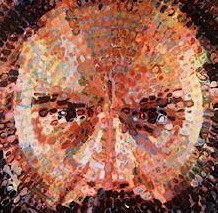
And yet, sometimes if I, say: decide to go out to paint a landscape, I
am likely to choose a time of day whose light & shadow I like &
then if I wander in the country-side with an easel on my back & my
paints & brushes in a bag over my shoulder, my natural instinct is
to find a beautiful old tree with many human lifetimes of character,
battle scars & evidence of centuries of struggle with climate, or I
might choose a group of trees that from a certain angle make a nice
composition (apropos the bucket-full of criteria I have that go all the
way back to the lessons of Vitruvius via influences that might include
anything from Japanese woodblock print & delicate Mughal temperas,
to Giotto, Il Ucello & Rubens) or maybe I'll be impressed &
inspired by a panorama of distant mountains topped by a dramatic cloud
formation.
And it sometimes makes me pause to doubt & I have to ask myself:
Even if your eye is able to find a beautiful composition those more
unused to looking for them could not, aren't you still being lazy about
your aesthetic theory? Looking for something beautiful, regardless of
the depth of criterion, from which you can base a beautiful painting?
So sometimes I instead, head for a tree that offers my canvas shade, or
stop anywhere at all at random, set up my easel & then
look around. If I happen to have chosen a particularly dull spot with
no obvious composition, attractive light or beautiful component, I
challenge myself to use my allegedly trained eye to find the beauty to
show you (the viewer of my eventual painting) while simply avoiding
painting what would otherwise distract the untrained eye from its
presence.
Once the brush is in the hand & the artist's mind engaged, it really doesn't matter what he paints, it's all in the process, the love of beauty, & his power to invoke it a little better each time.
I'bn al Alhí's treasure (2700 words)
The day rose rainy & you can believe me when I tell you there is
no weather more disagreeable in all the world than the winter-wets of the
desert on that lost & forlorn island.
We were four men, well prepared & equipped & the goat, of
course. We had camped among the dunes on a clear, cold night the
day before, the same spot we were abandoned by the camel drovers who
would take us no further. We slept confident the weather would hold
just the few days more we needed to be the first to see the legendary
ruins of I'bn al Alhí built of bricks of gold whose beauty was
enhanced by painting them with a thick black lacquer imported by ship
& mule all the way from Nippon.
After years of obsessive research & niggardly penury it was I who
barely financed the venture though I counted more than I would have
liked him to know on my right-hand man, Chûen Chïi, the man
I trusted better than myself to know what to do whatever the
circumstance. He had grown so remotely in the treeless high-desert of
his homeland that he & his kin’s only drinking water, raised
from a deep & muddy well, was slightly saline. The years of being
obliged to take salt whenever he tried to quench his thirst, along with
the unabating dry, cold winds, seemed to have sucked all the juice from
the man; it was as if he were made of sand held together with the
minimum amount of gum-arabic to keep him in one piece though not enough
to stop the constant shedding of sand from his edges even just after
he’d bathed. He seldom spoke but always understood what was
happening around him, in whatever language, & walked in a way that
let other men know he wasn’t to be fooled.
My years as academic, spending time in far-flung corners of the world
but always ensconced within a similar cocoon of ancient libraries or
temples, at times even learning new languages to be the first to
translate the old papyri, hadn’t really prepared me for this trip
but I had an adventurous nature & I knew how to learn. I read all
there was on what I would need to know to survive the dangerous trip
& despite my scholarly history I, like all the men there, could
feel with my every cell the weight of riches that awaited us in those
blackened gold bricks.
As the morning wore on the rain and wind turned the air to a thickness
not just of air-filled sand as in a mere sandstorm, but wet
sand, just as that that slipped & sucked at our feet whether we
stood still or walked; it was very like after having been pulled to the
depths of a deep patch of quicksand, one stood & went for a walk.
We all worried about little Prajeet, the youngest & weakest of us
& I more than any other man there, because I not only had him to
worry about but also the guilt I would have to suffer if I, responsible
for permitting him to come, let harm befall him. But he showed neither
fear nor reproach on his features & it made me aware I had better
not show any myself & be the only one of us but the goat who did.
I looked to Chïi, as always, & his eyes, as always, awaited
mine & though, as always, he said nothing, I knew his raised
eyebrow meant: “Don’t worry Saab, at least the nomad
bandits, with their untold generations living alone in these wilds will
have had time to learn not to go out in weather such as this, & so
at least we no longer need worry about being attacked by them”
Wonderful, I thought, he’s right! We have the advantage over
them of sincere ignorance, & I readied to move forward, heartened.
Albert, the impossibly tall, hairless & rattlingly thin Australian,
pulled the compass from the unfathomable folds of his mud-soaked robes
& by the device of pulling loose a bit of his turban & holding
the compass very close to one eye, he was able to see the needle's direction and
thus keep us moving in the intentioned direction.
I told myself just as I’m sure each man there did himself: Tomorrow the storm will have passed.
No-one there doubted the madness of the venture but neither did anyone
mention it as we all knew it was madder still to do nothing at all. The
distance to our objective was far shorter than the two day camel ride
that had brought us from town. The few supplies our goat carried,
including her own meat, were barely enough to get us there & back
to our appointment with the camels. I had decided to spend on the extra
man instead of the wide-hoofed local donkey that might have served us
better. The bags we carried strapped to our bodies were mostly empty in
wait of the weight that would fill them on the way back.
There were times that though we walked on a flat or along a
dune’s ridge, the air ran indistinguishably into the earth &
though we took one step after another there was no way to know if we
progressed a step with each footfall, or stayed in the same place as
the earth slid beneath us. At other times we had to rescue our goat,
beard deep in sand, bleating horribly & instead of her carrying our
weight for us, the four of us, took one cloven hoof each & carried
her & her load upside-down & bleating pointlessly all along.
When we had to climb a dune we decided to brace arms thus making an
eight legged creature we reasoned could more easily take two steps
forward for every one it slid back, rather than the other way
‘round, which is how it appeared to work for a two-legged
creature. At these times we had no choice but to say: “Goat be
damned! We can do no more than walk” But probably even more
scared & disoriented than us, she managed somehow, to keep up with
her mad herd even in the most difficult moments.
The noise of the deluge of sand-mud made it almost impossible to speak, what made it actually
impossible was that no matter how we covered our faces with our
turbans, our mouths & noses were irremediably filled with sand- the
only sand in the world that was dry… we decided things between
us with nudges & nods… without even space or time to think
of the gold at the ruins of I'bn al Alhí.
We trudged along the base of a dune seven stories high in an attempt to
shield ourselves from the worst of it, though we couldn’t be sure
the dune’s rate of shift wasn’t pushing us off-course as it
gathered around our ankles at every step.
When suddenly!: A shaft of light like a hole cut into the very fabric
of reality through which shone a sun & sky as bright &
unblemished as the middle week of August in Cape Cod. And I realised:
“Of course, just a couple of hundred metres above us it is a nice
day”
It was then I saw them, as dramatic in silhouette against that shaft of
light as the best video game. Four men, maybe six, or ten, if there
wasn’t another dozen standing just the other side of the ridge
out of our range of sight- indeed, though I looked straight at them
& they stood as still as stones, any number I might have counted
would have been a wild & irresponsible speculation. But I managed a
dry & gravelly shout: "Bandits" & all eyes but the goat's
turned to where I pointed.
Though the sight of them stabbed my heart with adrenaline-fear, all my
animal instincts, like those of a rabbit, said: “RUN AWAY, RUN
AWAY” yet there was also a sense of the security of being able to
postpone fear, like after an unexpected medical diagnosis, simply
because of the great distance that separated us from their height at
the top of the ridge as well as the un-scalable short side of the dune
that rose above & between us like the Grace building in New York.
And like the tourist I inevitably was, for a fraction of a second I
actually felt the urge to take a photo, though I carried no camera.
But feeling suddenly as if I had entered a parallel universe that
worked under different laws, with a sickening lurge of my innermost
bowels, I & the others watched as the nomads began the physically
impossible, slow but relentless walk, down that very face of running
sand. Unlike when we had tried descending even a gentle slope, however, the sands did not avalanche under their feet.
As soon as they left the ridge & the shifting shaft of light,
they blended with the sand-wall's shadow, their edges becoming
indistinct, their number & movements, unclear.
My recent optimistic ignorance, or was it ignorant optimism? Fell away
& it occurred to me that countless generations living in these
circumstances would not have learned not to go out this time of year
but rather how to fashion shoes & clothing that worked in it.
It was then I remembered what I had read of their weapons, short
lances attached to long cords with sharpened bone tips shaped like
fish-hooks that, once hooked, allowed them to pull a man about like,
well: like a fish on a hook.
We none of us hesitated in pulling whatever weapon he carried, Bolele
drew a small but extremely heavy ebony club as black as his own skin
& he looked, reassuringly, like he had used it before. Bolele 'The
Lip' as he was known by his people since they were a culture of ironic
humour & Bolele had no lips. Indeed, even the sloppy slanting gash
that revealed his skull's grin seemed to have an ironic curl.
I pulled a pistol I had bought in a street market in Peshawar without
being entirely convinced it was up to the task of shooting the four
bullets I owned. I then turned to Chïi with the wild hope he might
pull out a heat-seeking missile launcher or something like that; but he
stood calmly, a small hatchet of the sort used for splitting kindling
hung loosely from his hand at his side. I looked to Prajeet who was the
last to pull his short scimitar, knowing his religion obliged him to
draw a man’s blood, even if it be his own, before he be allowed
to return it to its sheath.
But before I had time to look to the last of my group, the goat,
Chïi raised his arms lazily as if about to yawn & as the
menacing shadows moved inexorably towards us but were still at a great
distance, his hand flew forward with the thin dry strength of a farmer
& the speed of a baseball pitcher. I don’t know if the man
cried out. The deafening drone of rain had robbed us of the use of our
hearing but he fell with inhuman speed & one imagined the sickening
'thuck' as the hatchet lodged deeply & suddenly in flesh.
They huddled indistinctly, we stood our ground, waiting, watching, a
few long seconds & I cannot speak for the others but I know my mind
raced, examined, analyzed, debated, considered & weighed at
incredible velocity & with blinding precision & yet my body was
paralyzed & no decision seemed forthcoming.
As I stared & waited I was suddenly roughly jabbed into action by
Bolele’s club & I saw some of the others had already started
to run, in slow motion as if knee-deep in water at the beach, or
barefoot on gravel- arms flailing- away from the wall of sand & the
nomads.
We all ran, but at a short distance we realised too late we ran not in
the valley between dunes but along one of its ledges & a distance
we could not judge for lack of visibility awaited our fall. We had no
time to rethink because by the time the first, Al, the long-legged
Australian, reached the edge it rapidly fell away & we all of us,
with it.
I have no idea how far we travelled either in measure of distance or
time, as part of that sand fall, but when we came to a stop I was under
wet sand without any way to calculate if it were two metres or two
thousand that covered me. I panicked, I admit it, but my body knew what
to do & my arms automatically reached for the sky like a seed from
under earth. I noticed with my first movement that if I crouched my
head forward, then raised it, I could create a tiny pocket of air from
which to take breath before it refilled with sand & I immediately
calmed down. I pulled myself out of what turned out to be nearer the
two metres than the two thousand & saw Chïi already digging
around for the others.
Once we had all helped each other to the surface of the sand, we sat in
a heap, all leaning against the other, with no less reason for fear
than we had just a few minutes earlier but already more confident
having shared & survived danger together.
As we lay/sit, breathing hard, we may not any of us have yet thought
what to do next when a new sound, very loud & throbbing & then
shrieking, like a hyena poked repeatedly with a sharp stick, forced
itself on my consciousness. I sat up, we all sat up, alert as those
amusing little desert animals that raise on their rear paws to be able
to see danger further away.
My mind, my rational & scientific mind, filled-in the disembodied
sound with wild images of dragons or Greek Succubae, or screaming
hordes of nomads mounted on rhinoceroses. Someone got to his feet &
started jumping up & down waving his arms, & then we were all
doing it as a strange-looking vehicle with 8 oddly placed wheels,
rumbling engine, screaming alarm & lights shining in all directions
that cut through the murky atmosphere like lasers, drove & bounced
towards us.
Upon noticing the vehicle was not a dragon: my mind back in its
territory, it was able to quickly deduce- “Of course, you pratt!
We are not the only group of complete imbeciles to try & do
something absolutely imbecilic in this country’s dangerous
country, the camel-men had told of the foolish foreigners & the
locals had sent out a rescue team…”
So near to getting help I felt suddenly apprehensive, I looked back
over my shoulder, but the nomads had disappeared. Had they actually
been there? Had Chïi really killed one of them? Or had they been
no more than shadows created by a mixture of fear & the
disorienting effects of the shifting light & thick atmosphere? Or
perhaps the lack of physical dimension- with no depth or breadth or height
in which to orient spatially even the perception of the temporal slips
from one’s objectivity…
Now perfectly safe among the mocking but friendly faces of our
rescuers, I gallantly waited for the last of my team to file into the
wheeled machine. Prajeet, the penultimate, stopped & turned to me
with a proud smile as he cut a deep gash in his thin forearm before
sheathing his knife & climbing in. I waited finally for the goat
who might play an important role in the dinner upon our famished return
to town, before I reached for the head-bar with my hand & stepped
up to the vehicle’s floor with my foot, but it was then that I
slipped & fell forward giving myself a nasty cut on the brow with
the edge of the door.
And that, since you ask dear friend, is how I got this scar on my eyebrow.
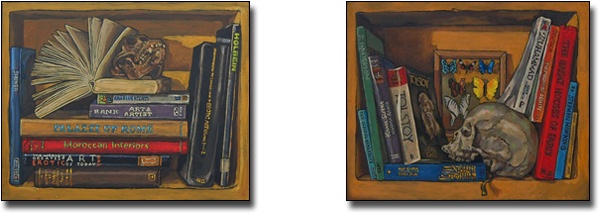
The first time I light-heartedly mentioned the fact in conversation,
that despite being a slave to my biology & as susceptible as the
next man to the exhilarating if ill-effects on my powers of reason the
subtle nuances of the unique form a particular Gluteus Maximus might
have on it; I have, never-the-less, as I got older, more & more,
begun to see others largely as large insects, all fussy little dangly
bits at the extremities, flashing those awful & sinister visible
bones used for breaking food into pieces small enough to swallow down a
spongily-muscular & very internal tube… my
listener backed away a step or two & calmly lit a cigarette, though
his hand trembled, & he explained to me what ‘dissociative
personality disorder’ meant… & I decided it was
probably best not to mention the voices...
Before I scare you off the rest of this essay by convincing you my mind
is actually & dangerously unstable, rather than just, uhmnn:
different, yeah, yeah, that’s it… different! I do
exaggerate a basic truth in an attempt to be amusing.
But allow me to share a little recently learned background information
before getting to my thesis. There is a tiny part of the brain which,
through the study of people who suffer cerebral lesions or tumours, or
those lesions or tumours induced by us in animals not strong or smart
enough to stop us (like lab rats & monkeys), is in charge of the
mind’s understanding-- it & the body-- belong to one another.
In the absence of the communication between this part of the neural
network & the rest of the body not only can the sufferer look on
dispassionately as one of his limbs is amputated but actually, in a
real way, will not be able to rationally recognize his body as part of
himself.
A fascinating (if not entirely conclusive) study was done to try
& objectify testimony of personal paranormal experience through
neuroscience, which is increasingly turning psychology from a soft
science to a hard one by succeeding in ‘seeing’ with new
precision, the biology of thought. The big advance has been in
magnetoelectroencephlography where almost, but evidently not
immeasurably small, blood movements bringing oxygen to the neurons
called upon for the task, can be followed on a three-dimensional
construct of the brain on a computer screen. Very like the science
fiction of not-so-long ago.
In brief summary -1:
The paranormal experiences referred to might be any, from a divine
vision (like those experienced by the prophets of most religions) to
the ‘light tunnel’ described by so many who have near-death
experience, to those damned cosmic aliens that always turn up when one
turns the lights off… or don’t they visit you too?
Actually I was only joking, I do not have any problem with cosmic
aliens at all, I just leave the lights on all the time.
The subject (one of 900) was placed in a near sensory-deprivation
chamber & his temporal lobes tickled by electromagnetic energy of a
precise wavelength to test the premise that “…when the
right hemisphere of the brain, the seat of emotion, is stimulated in the cerebral region presumed to control notions of self, and then the left hemisphere, the seat of language, is called upon to make sense of this nonexistent entity, the mind generates a sensed presence”
Resulting in: “…different subjects labelling these ghostly
perceptions with the names that their cultures have trained them to use
- Elijah, Jesus, the Virgin Mary, Mohammed, the Sky Spirit. Some
subjects have emerged with Freudian interpretations - describing the
presence as one's grandfather, for instance - while others, agnostics
with more than a passing faith in UFOs, tell of something that sounds
more like a standard alien-abduction story”
According to Dr Persinger, responsible for the study, this tiny, faulty
process between our cerebral hemispheres is the reason for both
external & internal versions of the same sensation, externally it
might be a vision of God or an angel, while internally it might be a
past-life sensation or awareness of one’s own soul.
“…but modern neuroscience isn't shy about defining our
most sacred notions - love, joy, altruism, pity - as nothing more than
static from our impressively large cerebrums …many things that
we hold to be unique aspects of the "self" are reduced to mere tics of
cranial function. Take laughter. According to Vilayanur Ramachandran,
professor of neuroscience at UC San Diego, laughter is just the brain's
way of signalling that a fearful circumstance is not really so
worrisome …he posited that the classic banana-peel pratfall is
funny only when the victim gets up, and that we laugh to alert other
members of our kin that, 'Look, there has been a false alarm here;
don't waste your resources rushing to help.'" He calls laughter
"Nature's OK signal."
Which, it seems to me, could be why we feel those who laugh too
little are untrustworthy- perhaps some part of our brain is whispering
to us: "He isn't of those that go to the trouble of warning those close
to him"
“In The Origin of Consciousness in the Breakdown of the Bicameral Mind,
Julian Jaynes, a Princeton psychologist, argued that the brain activity
of ancient people - those living roughly 3,500 years ago, prior to
early evidence of consciousness such as logic, reason, and ethics -
would have resembled that of modern schizophrenics. Jaynes maintained
that, like schizophrenics, the ancients heard voices, summoned up
visions, and lacked the sense of metaphor and individual identity that
characterizes a more advanced mind.”
PCP (phenylcyclohexylpiperidine) known to the Hip (like James Brown) as Angel Dust (Man!). And yes, I  have
tried it; why? You ask? Well, I suppose it couldn’t have been
other than a combination of youth, ‘when in Rome…’
& the reason the mountain-climber scaled the mountain.
have
tried it; why? You ask? Well, I suppose it couldn’t have been
other than a combination of youth, ‘when in Rome…’
& the reason the mountain-climber scaled the mountain.
This drug, whose effects on the human mind are particularly horrifying,
were developed by- surprise, surprise- chemists working for the U.S.
military. But not, as one might suppose, to create raging &
fearless, assassin-soldiers (which might have worked) but instead as an
alternative to Morphine or anaesthetic to help the wounded soldier, on
the field or under the knife, after WWII.
The idea was that instead of anaesthetising the nerves that otherwise
clamoured for attention with screaming pain, PCP introduced
intravenously, would affect the wounded with cognitive dissociation
from the body that made its pain irrelevant to a mind that would
otherwise take it very seriously.
They eventually stopped using it for this purpose & listed it as a
‘schedule II’ illegal substance because they noticed their
patients became irrevocably insane when it was administered to them.
If not only our pain is not actually our own but even the body that
feels it is ours only by tacit if aleatory, chemical agreement, &
if cognitive metaphor is not a function of linguistics but of thought-
i.e. we don’t create metaphors with words because we have words
to play with & happen to have poetic natures, but rather because we
think metaphorically & consequently find words to express such
basic abstract thought as: ‘Life is a walk first uphill, then:
down” or “She was as beautiful as a slice of the Moon” -2 .
It points to our fundamental propensity for the creation of the reality
we live in rather than its objective experimentation- that reality is
the mind's construct rather than the converse.
Then the question naturally occurs: If it be just a tiny bundle of
cells, a nearly insignificant amount in comparison to the whole being,
that is solely responsible for each individual's ability to recognize
himself as such- an individual, then, in the end, it is really only a
question of scale innit?!
If it weren’t for our subjective point of view as creatures of
a size a pile of ten trillion cells makes, & we were, instead, of a
size small enough to see molecules, well, a creature that size would
not be able to recognize one our size as a discreet form. So if we are
in fact just swirling masses of atoms, each made of far more space than
matter, who’s only distinguishing factor in the context of making
up a part of us is a closer proximity to one another than those that
surround our fuzzy edges, the question becomes not how can a mind lose
its association with the body but why, indeed, is there any association
to begin with?
footnotes:
1-For a full (4400 word) report by Jack Hitt, the reporter/subject quoted in my God Blog & above, go here- This is your brain on God -Return
2-
A personal favourite from the Old Persian tales. (The sentence forms a
simile but ‘slice of the Moon’ is metaphorical) Return
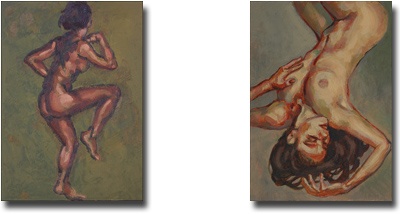
Love poems, death poems (600 words)
Love
I can nail my left hand to love’s cross by myself
but I will need your help Dearest,
with the right.
We occidentals can know nothing of the poetry of haikú which belongs as exclusively to Japanese language & culture as Shakespeare does to English, Dante to Italian, Cervantes to Spanish & I suspect, even more so. But yet, I find them sometimes so incisive they manage to transcend meagre translation:
SUANAO's death Haikú-
Spitting blood
clears up reality
and dream alike.
It was said of Basho's widely acclaimed poem (18thC) below: the poet sought: "...a vision of eternity in the things that are, by their own very nature, destined to perish." Benjamin Moser comments: "It is as difficult to achieve a simplicity of this kind as it is to build a great cathedral, a simplicity all the more elegant for its apparent denial of its own difficulty. ...concreteness & simplicity, rather than intricacy & elaboration, were the highest values of this [Buddhist] culture"
Kind of makes you want to learn Japanese, hu?!
I've read Shakespeare in both English & Spanish, as well as Cervantes; & Dante in both Italian & English, & I'm convinced if any of the three wrote the same way in a tongue other than their own, none would be remembered today (Shakespeare in Spanish is particularly atrocious! Indeed, worse: without the Elizabethan stress & lilt his work goes from extraordinary to something worse than bad: ordinary)
BASHO's Haikú-
The old pond, ah!
A frog jumps in:
The water's sound!
Below, two poems that belong somewhere in the collective memory of all English speakers- the first written by that American poetess so sensitive, so discreet, so courteous, she makes it feel instead like a poem of love... note how the last line of the last stanza rhymes only with last line of the first- 'immortality & eternity' (with her customary 'civility' in between!) & to me she seems to ask: do both exist? Or only one?
I disagree with the common reading that her declaration about a century (after her death) feeling shorter than a day (prior to her death) shows her calm acceptance of a better life after death but rather it was the labour & leisure she put aside that made the days so interesting they seemed longer than centuries. The long day referred to in particular is, after all, that when she first surmises eternity, not immortality.
And for a clearly less 'biblical' reading try this little gem also by Emily- Truth & beauty- which, I would say is metaphorical rather than allegorical; if the thoughts of this solitary person who dedicated her life to the twin pursuits of the science of horticulture & the art of poetry, turned to truth & beauty, don't you think her musings have their seeds in her own experience rather than simple conceptual thought? Your thoughts?
The second, by Robert Frost, was memorised by whole generations of children & embodies the deceptively simple but powerful vocabulary & structure typical of American writers from Twain to Runyon to Hemmingway or, most surprising of all: Dr Seuss (Theodor Seuss Geisel), whose verse's enormous power to ignite & delight the imagination, though it appear almost spontaneous-whimsical nonsense, is actually based on a metre so complex I couldn't understand it when I attempted its study!
You might be as surprised as I was to realize Frost died (very old it's true) the year I was born & he wrote the musings on death below, at about my age now but in 1922.
Because I could not stop for Death
 Because I could not stop for Death,
Because I could not stop for Death,
He kindly stopped for me;
The carriage held but just ourselves
And Immortality.
We slowly drove, he knew no haste,
And I had put away
My labour, and my leisure too,
For his civility.
We passed the school, where children strove
At recess, in the ring;
We passed the fields of gazing grain,
We passed the setting sun.
Or rather, he passed us;
The dews grew quivering and chill,
For only gossamer my gown,
My tippet only tulle.
We paused before a house that seemed
A swelling of the ground;
The roof was scarcely visible,
The cornice but a mound.
Since then 'tis centuries, and yet each
Feels shorter than the day
I first surmised the horses' heads
Were toward eternity.
EMILY DICKINSON
|
Stopping by Woods on a Snowy Evening Whose woods these are I think I know. |
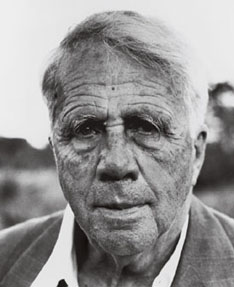 |
The Golem (550 words)
In questions of philosophy & psychology the strangely, morally obscure, tales of the Talmud  are
enormously polemical as well as just plain damned-good story telling in
the vein of their still polytheistic Arab brothers of the same epoch.
As theological tracts they are sometimes wise, sometimes perplexing,
sometimes cruel but always unforgiving.
are
enormously polemical as well as just plain damned-good story telling in
the vein of their still polytheistic Arab brothers of the same epoch.
As theological tracts they are sometimes wise, sometimes perplexing,
sometimes cruel but always unforgiving.
As the infidel famously said about the Old Testament: “I have
read it from cover to cover but cannot find any religion in it.”
For instance, for the book of Job, I can see Sean Penn in a Fedora as
the devil. Staged in a film-noir contemporary NYC, turning his earnest
face into a sardonic smile as he watches Rowan Atkinson (as God)
doddering off to the task he just tricked him into: committing a sin
far worse than the devil's own by provoking Him to it- the senseless
& cruel torture of Job’s tribe, slaves, animals & even
neighbours (fooled themselves to sin by the betrayal of Job in the
belief he must hide some evil malfeasance for a Just God to treat him
so). And all for the sole purpose of winning a bet- proving a moral
point to someone whose opinion should not matter to him- the devil,
involving him in the further sin which, ironically, was Lucifer's own
original cardinal sin- that of pride.
But I like the Golem who appears in various forms since his Talmudic
origins. In one, he turns from protecting his maker to do him violence
wakened to his own will by love. In another it has the Rabbi Judah Loew
ben Bezalel creating the Golem of clay in order to use him to defend
his people from the Holy Roman Empire’s Rudolph II who, in the
16th century, threatened to exile or kill all the Jewish people living
in Prague. In this case the Golem does not turn on its maker but since
Rabbi Loew had animated him by writing the word ‘truth’ or
'reality' (![]() -Emet)
on his forehead; when the Emperor promises to desist from his
anti-Semitic threats if the rabbi will stop the soulless beast, Loew
erases the first letter (
-Emet)
on his forehead; when the Emperor promises to desist from his
anti-Semitic threats if the rabbi will stop the soulless beast, Loew
erases the first letter (![]() -aleph) from Golem’s forehead turning Emet to Met (
-aleph) from Golem’s forehead turning Emet to Met (![]() -Dead) thereby deactivating it. In this case Golem, turned inanimate, falls on his creator crushing him to death.
-Dead) thereby deactivating it. In this case Golem, turned inanimate, falls on his creator crushing him to death.
I see the story describing the use of power for self-interest as an act
one must pay a price for after; but metaphorically I see the Golem
personifying guilt & in this sense, Jewish wisdom. If one uses
one’s own Golem, his power, in the form of say, physical strength
to exploit someone weaker, that power turns on its owner in the form of
guilt which makes the Golem’s master learn not to animate new
ones.
Elitist/Popular Art (1740 words)
I saw a series of short interviews where people taken from a cross
section of society were asked the single question: What is art? Even I
who have studied the question, informed myself of other's opinions,
considered it over a life-time & even shown the hubris to write
thousands of words on the subject- would be hard-put for a short,
concise answer.
I observed, however, that among the mostly, conceptually-clueless answers people gave,  there
was a general sense of sincerity & passion- as if despite their
lack of criterion they all agreed it mattered for some reason they
couldn’t quite put their finger on.
there
was a general sense of sincerity & passion- as if despite their
lack of criterion they all agreed it mattered for some reason they
couldn’t quite put their finger on.
One young man said art made you feel something but
only qualified if it was unpretentious (by this I believe he meant art
which needs no background knowledge to understand it)
And a young lady, stopped while exiting an art museum, with serious but
unabashedly bewildered expression, said she enjoyed looking at art
though she couldn’t say why & went on to declare, she
didn’t understand why there was a toilet exhibited beside the Van
Gogh as art but, it was: “Fine by me”.
An impressively open mind, but if someone had summarised for her Duchamp’s deep concept -1
as simply & superficially as: “Since it is the artist’s
eye that creates art, if that same eye finds art
‘ready-made’ (which the Philistine has failed to observe
for lack of aesthetic sensibility), then it becomes art by the
artist’s right to claim it so” It might not mean our young
lady would necessarily become suddenly able to appreciate the urinal
as art or even as beautiful object; but she could at least, & at
last, decide she doesn’t like it simply because she now
understands it.
Indeed, without any further information about art, art history, the philosophy of art, its  techniques,
evolution or variety throughout cultures, she could offer intelligent
argument why she disagrees with the brilliant thinker who influenced
all art theory after himself.
techniques,
evolution or variety throughout cultures, she could offer intelligent
argument why she disagrees with the brilliant thinker who influenced
all art theory after himself.
Apropos the same theme of elitism in art is the very unusual fact
Marcel Duchamp is remembered as an artist at all when he hardly
produced any art at all. The significance of this to me is that Duchamp
still, at the beginnings of the twentieth century, found himself in a
society mutually interested & informed enough to allow their
thoughts about art to be influenced by ideas about visual art instead
art in the form of images.
In the 16th century Michelangelo's sculpture changed all of
Europe’s art theory through no more than a hand-full of bad
engravings that travelled. (In today's reality they would have been no
more than one more forwarded e-mail among the already indigestible
amount of new visual information that enters our consciousness each
day).
If we step up a stair in the taxonomy to talk of aesthetic theory
instead of its manifestation as art, I think no-one would claim good
taste is innate rather than learned- indeed: motivated by ambition. No
matter how beautifully turned a woman’s ankle or perfectly formed
her foot, it takes effort, experiment & study for her to learn
which shoe design flatters the shape & length of her legs, her
posture, her gait- which cast: her skin tone, clothes or hair
colour… It is in fact a refining of aesthetic sensibility
through the application of observation & reflection.
But bear with me awhile & allow me to build my argument a little longer before naming my point.
During the time of the Medici, the Sforza, the Borgias & the
viciously Mafia-efficient pyramid scheme that was Europe’s
church, took charge of what was painted, their aristocratic good taste
(allowed by the privilege of leisure time, travel, study & informed
society instead of say, battling the earth sixteen hours a day in
exchange of potatoes) resulted in three centuries of brilliant work we
refer to as the Renaissance.
By the 17th century, however, there was an economic shift due to trade
organised through the ports of Rotterdam & Amsterdam & the
puritan Protestants, dressed in black with simple white collars, could
suddenly afford to spend the price of a house on a tulip bulb. And it
became they, the bourgeois; the accountants, the traders, the
merchants, the lenders & speculators, who began to influence what
painters painted.
What resulted at the loss of the privileged class’ educated
influence on what was painted? -The artist turned from the
idealised portrait & the symbolic images of mythical religious  figures
to the objective examination of the reality around him & finally
the psychological portrait was born. The portrait not meant to idealize
or symbolize but to reflect honestly what life has written on the form
of the sitter.
figures
to the objective examination of the reality around him & finally
the psychological portrait was born. The portrait not meant to idealize
or symbolize but to reflect honestly what life has written on the form
of the sitter.
Why did it make no difference? Why were painters able to create
works of lasting & sublime beauty under both circumstances? It is
because the buyer directs the painter through natural market forces,
what to paint, but cannot tell him how- the true artist (& not all
painters are) is the only one educated in his means of expression well
enough to decide how to paint with it -2.
It is the artist's education that counts, not the patron's; it is he
who is charged with finding beauty wherever his gaze is directed. As
great artists as both Leonardo & Michelangelo might be, neither
could have painted like the other even if he dedicated his life to
trying.
By the time Abstract Expressionism had killed any interest the common man -3,
(already lost by the advent of cubism half a century earlier) still
had, a window dresser for Saks Fifth Avenue (well trained in capturing
the common man’s eye) appeared on the scene with a new art
theory: art for the common man, Popular Art. “Why?” He
asked, “Should art be elitist?” Why shouldn’t art be
for the man-on-the-street to appreciate, instead of just the entitled
few?
Instead of intricately wrought objects created by hands trained by
decades of study, experiment & experience, why not paintings
produced rapidly with a semi-mechanised, photographic silk-screen
process & unmixed colours? (The common man won’t appreciate
the subtlety of a colour a painter trained by years of experience might
still spend hours getting just right, right?)
And so Andy Warhol, the theatrically greatest
self-invented/self-promoted art personality since Salvador Dalí,
introduced Pop Art. And finally art reached to its majority audience so
unjustly ignored all these years.

An important moment in art history? Well, how have his theories
affected art after? How have they affected the common man, largely lost
to the idea of art’s importance by a generation after the
invention of photography? And most importantly: Where are his works
now? The many still in private hands (& there are many, he himself
famously described his work space as factory instead of studio) mostly
belong to elitist collectors & today you won’t find even a
Warhol reproduction adorning the common man’s wall.
One might even argue Warhol betrayed his own artistic principle by the
fact that despite finding a fast, cheap & easily repeatable
technique -4 he sold his work at the highest prices the market would support instead of insisting popular art should have popular prices...
Art that is actually popular is more commonly represented by reproductions of works like Andrew Wyeth's 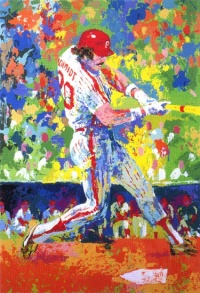 (clearly appreciable laboured technique + familiar ethos though he is
also an artist respected by cognoscenti). LeRoy Neiman's, the poor
man's impressionist, whose lucky break was as illustrator of the
Playboy 'Jokes' section & who for a decade or so had such popular
support as important artist that the same paintings that can't be given
away today were valued in the range of Picassos' in the 1970-80s.
(clearly appreciable laboured technique + familiar ethos though he is
also an artist respected by cognoscenti). LeRoy Neiman's, the poor
man's impressionist, whose lucky break was as illustrator of the
Playboy 'Jokes' section & who for a decade or so had such popular
support as important artist that the same paintings that can't be given
away today were valued in the range of Picassos' in the 1970-80s.
Or one of today's popular art con-men: Thomas Kinkade, whose work
enjoys such popular demand, while being found risible by artists,
serious  critics,
art lovers & collectors, it can demand prices that could get you a
minor but solid Renaissance painting at Sothebys instead, but will
never-the-less & without question, be relegated to the forgotten in
time.
critics,
art lovers & collectors, it can demand prices that could get you a
minor but solid Renaissance painting at Sothebys instead, but will
never-the-less & without question, be relegated to the forgotten in
time.
Uninformed popular opinion is loud but fickle, while expert opinion is
a whisper in the dark that persists through generations until finally,
over time, it imbues artworks with their actual merited value.
Throughout art history a greater amount of monies for a larger number of paintings supporting more careers, has been spent by the art-illiterate than the rare connoisseur & just as all of Kinkade's absurdly priced, artistically worthless originals, as well as the millions of prints, so most genuinely popular art ends at the bottom of a trash heap, its author's name forgotten, within two or three generations (about the same time it takes for something to become a 'classic').
Of course art appreciation is elitist! Just as theoretical physics or neuroscience is, anything that takes education to understand is elitist. The difference between those people interviewed having reasoned answers or not to the question: "What is art?" is education- the criterion with which to decide—& that doesn't mean they need
Note: There is irony in the fact that photography's first fifty
years or so (probably ending with Man Ray's post-WWI experiments with
the camera) were devoted to imitating the lighting, composition &
subject matter of paintings while today the most popular art is
photorealism: paintings that imitate photography.
footnotes:
1- More on Duchamp from another essay. Return
2- As Ingres said: "Talent does what it wants. Genius does what it can" Return
3- To give a simple, superficial & generalised definition of ‘common man’ in this context, let's say he who is uneducated in art, without any reasoned thoughts for its importance to society; who doesn’t understand its theories or know what to look at beyond the subject of a painting & is generally indifferent to the presence or absence of an art object. Return
4- Apart from his silk-screened portraits, or 'serigraphs' as they are pretensiously known in the world of art instead of the world of decorated t-shirts, he also produced portraits which were half hour long films taken with a camera unmoved on a tripod of a sitter posing in a chair- they were meant to be projected onto a wall-space that might otherwise hold a painting, played in loop indefinitely. Return
5- This painting in so-called 'limited edition' (edition of 5000 photographically reproduced prints on canvas along with other 'editions' on various other grounds- all unsigned) go for around $800.
A true limited edition in the world of art is, say- a copper engraving or woodcut of which no more than 200 prints are pulled & hand numbered (1/200, 2/200 etc) when signed in lead or graphite. The original copper plate is then deeply scored with an awl in an X from corner to corner & kept as proof the edition is indeed limited to the 200 claimed. Return
Theory of the Mind (1460 words)
I have a friend who is working on a doctoral thesis in Psychology, but
since her English is poor & many of the studies she must read are
not translated to Spanish, she has taken to asking my help & I have
been learning about psychology incidentally.
And so I discovered the Theory of the Mind which is not
what it might sound like at first, it is not a theory about minds in
general but rather each individual’s relative ability to theorize
about another’s mind -1.
Neuroscience's advances with
tools like magnetic resonance & fluorescence images, are finally
turning psychology from a soft science to a hard one as we are able,
with greater & greater exactitude, to see biological
representations of cognitive process.
It began with developmental studies done with children; at which age is
a child able to distinguish between a lie & a joke? Feel sympathy
for another though he isn’t affected personally? Recognize his
own faux pas?
One study used three children: an observer who watched 'child number
one' hide something. When child number one was taken from the place she
hid the ‘thing’, child number two was introduced &
allowed to remove the item from its hiding place & hide it
somewhere else. The observer was then asked: “When child number
one comes back, where will she look for the hidden item?
They found that few children below 4 years of age answered “In
the same place she hid it”. Instead they said she would look in
the correct place, the one where the second child hid it.
The conclusion they drew from this was that the observer, being in
possession of the knowledge, naturally attributed the same knowledge to
child number one instead of having developed his theory of the mind
well enough to put himself in the place of child number one in order to
realize he had no way of knowing the object had been moved from where
he originally hid it.
The ability to theoretically represent in one’s own mind the
inner workings of another is the same ability needed for relative
success with the other executive functions -2 & is therefore crucial to the interaction necessary for success to social animals.
I think it was one of Desmond Morris’ books that taught me that
though all Mammals have whites in their eyes only the humans have
whites that are always visible; when most animals are looking straight
ahead the whites of their eyes are hidden altogether. He explained that
the evolutive purpose was social: as animals that work in a group on a
task such as hunting, we can communicate silently by simply looking at
each other or, by judging where the other person is looking, one can
pin-point the thing he is looking at. If you are standing at a bar
beside your friend & a girl looks over from ten metres away, you
know if she is looking at you or the friend that is standing at less
than a metre’s distance, thanks’ to the whites of her eyes.
We are able to judge, with surprising precision, the direction the
pupil is looking by its placement on the white background.
People working with primates, like chimpanzees, joined their observations to the 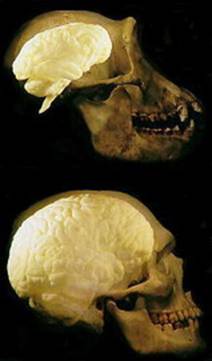 development
of the theory & it is now believed that the evolution of the
ability to judge another’s mental state had its seed in the
advantages of being able to decide when he was being fooled & when
he was told the truth: If you pick the fleas from my fur I will pick
those from yours after.
development
of the theory & it is now believed that the evolution of the
ability to judge another’s mental state had its seed in the
advantages of being able to decide when he was being fooled & when
he was told the truth: If you pick the fleas from my fur I will pick
those from yours after.
It seems the abilities for higher abstract thought like philosophising
(which, in our own minds, makes us superior in the evolutionary
hierarchy than animals without) stem initially from a primordial need
for street-smarts in judging the sincerity of others.
When explaining the evolutionarily stable ratio, Richard Dawkins uses a
certain species of bird as example. These birds have a problem with
ticks which can kill them. They are able to remove the tics without
undue labour from anywhere on their bodies except their heads.
These birds have no theory of the mind & must blindly obey the instincts given them by their genetic instruction. The bird born, by casual mutation, without courtesy, has significant advantage in a society such as this & can spread the discourteous gene quickly through the gene pool because he procreates more successfully than the courteous -3. But when you reach the intelligence of, say, a Chimpanzee, you have a wide range of tricks you can play on other chimps who aren’t able to judge.
Some scientists hypothesise that
the evolution of self-consciousness & the consequent
disproportionate growth of the seat of conscious thought, the
pre-frontal lobe, is due initially to the need to develop the ability
to decide when lied to.
And so, people suffering paranoid schizophrenia are studied under the
assumption it is this basic skill—being able to distinguish a real
threat from an imagined one—which has broken down i.e. their theory of
the mind is not working well & therefore, as a social animal, they
begin to feel everyone else could hurt them.
Not only does the work we put into appraising the many signs we give
each other, from inflection to gesticulation, take a huge amount of our
conscious, cognitive process’ resources, but in order to
determine the other’s interior processes, we also expend this
wherewithal on retrospective examination of our conclusions as well as
the consideration of which image we projected for the other’s
elaboration of a theory of the mind about us.
We can even expend this energy without realising it, for example, on fictional characters we see on the screen.
It occurred to me that if good theory of the mind is important for what
you do, if, say, you are a sixth grade teacher or a politician,
then investing a large part of your cognitive recourse on this activity
is recompensed by success in your endeavour.
Whereas, if you are a painter or a theoretical mathematician, the
application of a large part of your abstract reasoning ability on what
others are thinking, thinking about you, or in thinking your thoughts
about theirs (about what you make of these speculated interior workings -4) is a great waste of native ingenuity that could be put to more appropriate & efficient use.
footnotes:
1- A ‘mind’ is defined as the totality of one’s conscious thoughts and perceptions. Return
2- The concept is used
by psychologists and neuroscientists to describe a loosely defined
collection of brain processes which are responsible for planning,
cognitive flexibility, abstract thinking, rule acquisition, initiating
appropriate actions, inhibiting inappropriate actions & selecting
relevant sensory information.
The last of these:
‘selecting relevant sensory information’, is the very thing
Becker referred to when he claimed human character in itself is a
neurotic response to his environment. It could be seen from the
opposite point of view: instead of ‘selecting’ relevant
information it might be described as the ‘rejecting’ of irrelevant
sensory information. The amount of sensory stimuli a person rejects is
far larger than that which he accepts, assimilates or stores for future
reference. Becker saw us as defined by what we reject because what is
left is who we are. Return
3-
Dawkins goes on to explain that the reason the discourteous gene
doesn’t take over the whole population is that the community
reaches a certain ratio where they begin dying from the ticks. Hence: an
evolutionarily stable ratio is achieved where only a few cheaters can
survive among many courteous neighbours. Return
4- It is always speculation since it is based on a groundwork of mutual experience not always, in fact, shared. Its astuteness is based also on one's natural abilities to grapple with abstract concepts, the manifestation of the feedback offered by your interlocutor, your ability to read the feedback objectively, your point of view & the other's ability to manipulate that image. Return
Shorter of breath, one day closer to death (670 words)
El Camarón de la Isla was a Gypsy Flamenco singer. With Paco de Lucia, the founder of the ‘new Flamenco’ & though a junkie all of his life was also a universally loved national hero- considered by many, the best Flamenco singer of the latter half of the twentieth century. He died of cancer in 1992 at the age of 42. His last words were: “Mamá que es lo que me pasa?” (Mommy, what is wrong with me?)
Here in Spain, just as it continues to be in many countries of the world, the standard protocol is that the doctor who has diagnosed a terminal illness will tell the patient’s family but not the patient & in many cases the patient’s family also choose not to tell the afflicted he is dying.
Even television shows with certain pretensions to intelligent dialogue like Hugh Laurie’s Dr House or Bones, almost without exception, show the same death scene over & over again.
House’s team tell a father his 20 year old son is suffering from massive radiation poisoning & will, without doubt whatever, be dead in a few days. The last scene of the episode is the father holding his boy’s hand reassuring him he will be alright. The boy asks his father twice to please tell him the truth but the father insists on his lie; fade to black.
Bones: A young girl dying of a cancer that has metastasized through her whole body; Angela, the artist on the Jeffersonian Institute’s team, sits with her on a park bench outside the hospital, the young girl: “But I’ve never kissed a boy” Angela: “You will, I promise”.
Neither of these shows or any of the countless others in series or feature films, that show variations of the same scene, go on to show the final death agonies or the reaction of those left alive.
I guess the reasoning is that telling the dying person the truth will remove his hope &, therefore, the quality of the little life he has left. It is better to pretend truth is false than ruin his last days with the certitude of his actual situation.
I imagine the scene after the sick person dies where all his loved ones turn from his body in tears, having to live the rest of their lives with the fact their last days with the deceased were based on a lie.
Not to mention the fact their insincerity, while giving false hope, removes all hope of the dying going through Kübler-Ross' five stage process from: Denial, anger, bargaining, depression to acceptance, i.e. to make peace with reality before fading into pain or opiate induced oblivion.
I can also imagine that the opportunity for the victim to share in the feelings of empathy those close to him actually feel is a pleasure denied him by their having to hide the fact they feel grief in order to support the lie he isn’t in fact dying.
If we switch our attention to the survivors of the personal tragedy they also suffer by being obliged to talk with the dying loved one of a future they know doesn’t exist instead of a shared past they would enjoy remembering together, i.e. saying goodbye.
The fear most feel at the contemplation of their imminent death is, likewise, a feeling the one living it would like to discuss with his loved ones for the value their emotional support (they care) has in helping him through the five stages to acceptance. Those who sit at his death-bed cannot offer him this support because they must instead deny the real fear the dying feel, in order to keep up the lie he is not dying & therefore has no right to feel fear.
Am I lacking in some basic psychological understanding that has me suspecting an egotism on the part of the survivors that is the real motivation to their not telling? That it is because it is easier for them than the dying to withstand the loss by denying it?
addendum- 18th of November (430 words)
Having left the thoughts above with a question, I asked it of a psychologist friend but she had no insight to contribute. I considered the possibility it might be a cultural point of view, maybe informed by religion, but cannot find similarity enough in cultures so different that have one protocol or the other. My lingering doubt did, however, lead eventually to a thought that might have significance.
No one but a doctor is called on so often to deliver the news of imminent death & for certain specialists like say, an oncologist or cardiologist, it becomes part of their regular routine. A doctor needn’t feel empathy or engage the patient on an emotional level in order to be a good doctor & a surgeon might prefer a colleague operate on his daughter for fear his emotional involvement might affect his decision-making adversely (or a wife for fear it affect the emotional bond adveresely).
A good doctor, however, does realize that though it be a routine moment to him it might be the most devastating in a life-time to the diagnosed. A good doctor is prepared, he studies & devises the best way of avoiding insensitivity without emotional commitment- while the family of the dying have no such training.
Could it be that because the family given the responsibility of deciding whether or not to tell a loved one, are emotional as well as untrained, they react to the news in much the same way as the terminally ill does (with denial) but don’t get a chance to go through the other four stages to acceptance because despite their empathy they aren’t the ones actually dying?
This could explain the reactions of the terminally ill patient’s friends or family but still does not explain why a body of practicing medics (such as those of one country or another) would practice a protocol they must know is unhealthy & unjust.
If the patient who hears the news of his limited future decides to spend the time left writing a long letter to his children or in an attempt to climb the North Face, it should be up to him to decide according to the actual criteria.
But then when 'not telling' is practiced as protocol, it is more likely it isn't because the medical body disagrees with the point of view of their colleagues in countries that do tell the patient the truth, but rather because the particular cultural mores relinquish the responsibility of the decision to the family despite the fact the doctor knows there is a better way.
Last thoughts on ‘Death Scenes’- 30th of November (400 words)
When I started the essay titled Death Scenes, I had a few in mind but realised that any more than the two examples I gave would be superfluous. I now want to add the description of a death scene from one of my top three choices of all shows ever made for television: Deadwood. Unlike the other shows I mentioned whose panel of experts help the screenwriters put smart dialogue in their characters’ mouths, Deadwood’s dialogue is exceptional for the way it describes the characters that speak them.
In the first few minutes of the first episode we find a Sheriff alone on a spare set that holds a young man in its cell. We can see the prisoner has no education or moral infrastructure & we might imagine him as the sort who has dedicated half his life to back-breaking labour at low wages & the other half grabbing what he could, when he could, however he could.
The story plays out at night in the room with barred cell, its porch & a dirt road that fades to shadow in the depths. The young Man awaits morning for the death sentence he earned for impulsively & drunkenly stealing a ten dollar horse.
When the owner of the stolen horse arrives at the jail-house heading a lynch mob, the sheriff knows he can’t hold till morning but rather than allow these men to break the law, to assassinate instead of legally execute, he hauls the young man out & hangs him in front of the mob on the porch of the jailhouse.
The mob had surprised the Sheriff & prisoner while the latter was in the middle of Kübbler-Ross’ ‘bargaining’ step in the process toward acceptance of his own death. When the time of his execution is brought from 12 hours into the future to the present, to the now, he passes through the three steps restant, one after the other, in a scene of no more than 3 or 4 minutes.
The show is outstanding for various happy reasons (Ian Mc Shane, who I have known all my life as a Cockney antiques dealer from the long-running BBC series for one, deserves a Nobel or at least a Pulitzer for his role!) but the roots that will turn it in time, into a classic, lie in the brilliant dialogue.
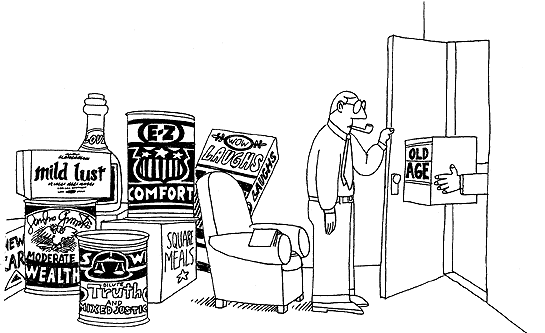
Politics II (1170 words)
Since I titled this essay Politics II, you may be wondering where Politics I got to; well, though nothing about my views can be construed as extremist like, for instance, any kind of support or excuse for terrorism 1 of any kind, as soon as I published Politics I the panicked letters from friends & family in the ‘States began to arrive. They worried what might happen to me if ‘the authorities’ (I don’t know, the CIA perhaps? Homeland Security?) got wind of it… at first I found their fears laughable but finally relented & removed the article.
And here I was thinking the U.S. constitution was based in a fundamental way on Voltaire’s principles of free speech 2. Funny those who care about me are more frightened by the possible punitive consequences of what I say than any threat inherent in my saying it.
When I was a gullible kid going to school in the ‘States I believed it when they told me only the evil Soviets lied to their own citizens, tortured their prisoners of war, that Brezhnev (or any of the USSR’s Premieres) would hurt, incarcerate or kill dissenters for simply speaking their mind & that I would not reach puberty if I smoked Marijuana.
The good guys, instead, always fought honourably & respected their enemy like John Wayne who punched hard but not after his opponent had fallen to the ground.
Here in Europe most countries have terrorists & have had for centuries, an unfortunate state of affairs one accepts like the far larger number of unjust deaths caused by say: drunken drivers.
There is no excuse or justification for terrorism against innocent citizens but in Europe we don’t panic. We don’t think we can find & kill the very last person willing to be a terrorist or threaten or dismantle the individual liberties of our citizens in hopes of finding that single e-mail, blog or 'phone call in tens of millions that might lead us to the person having ‘impure thoughts’. Even here in Spain with its outrageously cruel history the Inquisition’s powers were revoked by the beginning of the 19th century.
So now Obama is set to become the world’s most powerful man & I, who normally feel a passionate indifference for politics, am inspired to optimism for the first time in many years.
The part I don’t understand is the attitude toward his being a ‘black’ (of the Negroid race) president. When is society going to evolve beyond the belief in the relevance of the tone 3 of a man’s skin?
If we’re to use the term ‘black’ to describe how the physiognomy of a person might symbolize the culture he represents as we might a man from southern India, who will be far darker in skin tone than that Barack Obama inherited with his mixed racial genes, for example, upon seeing him & without further reference we will start making assumptions about his character & culture. He is likely of the Hindu religion with its cultural, behavioural & philosophical implications. He is likely against violence, he is probably vegetarian & eats with his hands instead of using cutlery, & yet, despite the tone of his skin, he is ‘white’ (of the Caucasoid race)…
But if we then speak to this Indian man we might discover he is a second generation Swede or Rumanian & that his physiognomy is entirely irrelevant to who he is & which culture he belongs to.
I remember when in London my youngest sister, who is from Laos (purchased as infant by my father & his Lao wife for 4000 Kip, about two dollars, from a prostitute who had more children than she wanted) came home from school crying at about twelve years old, she explained between sobs: “The other kids call me nigger”. Aside from incensing my anger like it might any elder brother I was also confused: “But you’re not black, you’re Asian…” (of the Mongoloid race) I later discovered that under U.K. law a black person is defined as non-white (I don’t know if this law is still valid but in certain parts of Britain it is certainly still the common attitude)
In Spain the traditionally poor & socially oppressed are the Gipsies 4 who just like American blacks are responsible for some of the country’s greatest cultural achievements; in Spain: Flamenco 5- in the U.S.: from the African music that came with the slaves through Gospel, Blues, Jazz, Soul to Hip-hop & the roots of all of the western world’s popular music.
So yes, though we finally move toward a healthy merging of cultures it can be said the black American has a culture that differs from American white culture but Barack Obama is not a representative of it while a man like Jesse Jackson or Dexter Gordon might be.
What we should be celebrating aside from Obama’s intelligence, dignity & statesmanship is his multiculturalism, in both genetic terms & that of his personal history because that, gratefully, is the inevitable future of modern man.
In 1993 with the the Maastricht Treaty & founding of the European Union began a process where countries with isolated cultures became less picturesque for the camera toting tourist but the blurring of borders & freedom of movement between countries began merging cultures in a way that will happen globally within a near future of maybe a hundred years.
It is time the human race grew out of its adolescence & the prejudice evidenced even by the celebration of a black president or one that has a vagina instead of a penis- it is the brain & not the body that makes the person an appropriate or innapropriate leader.
footnotes:
1- I would define today’s common usage of the word terrorism as war on non-combatants but its etymology comes originally from government intimidation of the populace during the reign of terror (Le terreur) after the French revolution that abolished (& guillotined) the monarchy in 1789- "If the basis of a popular government in peacetime is virtue, its basis in a time of revolution is virtue and terror -- virtue, without which terror would be barbaric; and terror, without which virtue would be impotent." [Robespierre, speech in Fr. National Convention, 1794] Return
2- “I disagree with everything you say Sir, but will defend to the death your right to say it” Return
3- …a quality of colour with reference to the degree of absorption or reflection of light; a tint or shade; value. That distinctive quality by which colours differ from one another in addition to their differences indicated by chroma (a colour’s relative saturation), tint & shade. Return
4- Spanish Gipsies are Romani, i.e. Indians who left the Punjab around the 11th century & arrived in Europe around the 15th. Return
5- Even Spanish people forget that Flamenco means Flemish, they took what was originally northern European music & applied it to their invention: the six stringed guitar (Prior to this innovation Spain, like the rest of Europe & northern Africa, used four stringed lutes) & evolved over centuries into Spain’s emblematic music. Return
This one of the series with the constellations between Aquarius & Pisces, God carrying the sun in a wagon pulled by winged horses (like Apollo) as men, women & animals work & freeze below.
Rock & Roll (670 words)
One of my oldest & dearest friends has been very excited by ACDC’s new album & now- world tour.
When I was an adolescent living in a steel town upstate New York, my friends & I thought ourselves too sophisticated for the Disco music of our day & firmly felt the future of popular music was in Progressive Rock (like those unique bands: Gentle Giant or Rush & Yes). I still think some of that music was solid- the musicians serious & talented but I would rather hear Al Green, Gladys Knight or Marvin Gaye today.
Despite our ‘sophistication’ we went to Kiss concerts & loved to play Zeppelin, Aerosmith & Peter Frampton at volumes that made our faces bleed from speakers bigger than the furniture in our bedrooms. And most of those bands did make at least some good music even if they had to steal it from the poor black musicians who wrote it but didn’t have lawyers.
I have a wonderful audio interview with Willie Dixon who, when asked how he felt about Pat Boone & Elvis' shameless thieving from the Delta blues, answered: “No one listened to us outside of the honky-tonks but Elvis took the Blues to the world & that is a good thing”
Listening to those Hard Rock & Acid Rock bands wasn’t really about the music, it was about personal expression, identity definition & camaraderie with our peers, it was a scream in a crowded room: "I'm here- I'm me, & that matters". Having studied the violin through my childhood I also loved classical music but played Bach, Caruso & even Brahms at volumes as deafening as Kiss’ nonsense, it is what kids have to do…
When Punk hit I was of age for bars & clubs (well, nearly, but things weren't as strict in those days) & soon moved to its epicentre, London, drank like a Cossack, took speed, acid & whatever else there was & bounced gracelessly around the dance floor with the rest of them.
Some argument can be made for the musical value of the Hard Rock bands, especially sensitive & evocative lyrics like those Ian Anderson (& his uncredited wife) used to write before he blew his brains on God-knows-what unusual combinations of dangerous drugs but Punk was the distillation of the part of Rock that wasn’t music, it wasn’t based on any idealism or musical principle, it was more a metaphor for the great line in that early Brando ‘B’ movie where when asked: “What are you rebelling against?” Brando answers: “Whaddya got?”
Even Punk's anti-social nihilism & originality turned, within a few short years, to standard uniforms made of toilet seat covers, safety pins & red Mohicans. Although their credo was not buying-in to popular culture, Carnaby street quickly turned into a Wall-Mart of these items manufactured just like blue jeans especially for that new market & young people made a living by hanging out there dressed as outrageously as possible so they could ask for money when American tourists wanted to photograph them.
Now, at 46, I don’t look down on punk, Hard Rock or the bad, loud music musically indiscriminating young people listen to today (& there is as much good & bad popular music today as in any age) it is just what young people need to do & should do.
But my old friend, a few years older than me, a man of exceptional intelligence, a research scientist & owner of a company that employs nearly 100 specialized workers, surprises me with his excitement at the bangers from Oz, men in their fifties making a living dressed in the short trousers of their school uniforms (the ones the brothers Young wore when they quit school & started a band).
Give me a dark corner in a smoky club, a deep glass of Single Malt & the mellifluous notes of Bird’s Alto ego & I will thank my lucky stars I’ve reached an age where I no longer have to suffer face bleeds with my music!
Words II- more words (740 words)
I have touched on the subject of religion repeatedly in these pages & mentioned the fact its fascination for me has made of me a keen student of theology for as long as I remember.
Despite study, both practical & theoretical, I have changed few of the fundamental truths that populate my early conclusions- the more new things I learn, new insights I encounter, the more I study those who disagree with me, the less doubt I have over my convictions.
Combine this curiosity with a nature that fell in love with reading the moment its puzzling & mysterious rules were explained to me & you have someone who at an early age required clear definitions of theology’s jargon, what exactly is Gnosticism? Theism? Religion? Spirituality? A miracle? Death? Soul? Reincarnation? Nirvana? Samsara? Eternity? God? God’s love? God’s power? God’s purpose?
Or even, for instance, the varying definitions of good & evil, each precise though some theologies are more honest than others in admitting paradox & ambiguity in their descriptions.
But there is one word that turns out to be particularly interesting for a few reasons: Agnostic.
Firstly, the word took on an allure for me when, having discovered its true meaning, I began to notice other people did not know it. Over the years it has become a quasi-scientific investigation for me where I repeatedly ask: “Do you know the definition of agnostic?” To people of all classes, ages, religious bent or culture, & have yet to encounter someone who either answers: “No.” Or upon claiming the affirmative can then go on & define it correctly when challenged… not one person in a life-time…
It has also worked for me more than once to liven one of those dismal dinners where the party refuse general dialogue & split into boring conversational duos.
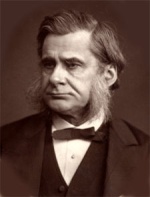 Secondly, it is a particularly interesting word because,
Secondly, it is a particularly interesting word because,
-
Unlike many, it is too young to have suffered any evolution in meaning through common usage.
-
We know the date of its coinage (1869) & the man who coined it
-
We have in his own hand an un-debatably concise definition.
The man was the brilliant 19th century British scientist & defender of Darwin in the famous Monkey Trials, not to mention the patriarch of three generations of outstanding thinkers: Sir Thomas Huxley.
He based the word on the ancient Greek gnōsis, knowledge or ‘to know’, just as atheist applies to theist. But though the grammar is similar their meanings do not fall into the same category, i.e. theology. Huxley’s agnosticism was based on the fact all we can possibly hope to know can only come to our awareness filtered inevitably by the only means we have: our five senses; reducing any belief arrived at without confirmation by our (subjective) senses mere & unreliable speculation.
Though Huxley himself as well as other important thinkers like David Hume & Bertrand Russell used the word agnostic within theological consideration its actual definition falls outside of these limits to the simply indemonstrable (& there is no reason one cannot be an agnostic theist); otherwise we would not need the discreet word: atheist. If an agnostic were just someone unconvinced for lack of evidence he becomes indistinguishable from the atheist who would also change his mind given new & incontrovertible evidence.
What Sir Thomas himself commented on one occasion:
When I reached intellectual maturity and began to ask myself whether I was an atheist, a theist, or a pantheist; a materialist or an idealist; Christian or a freethinker; I found that the more I learned and reflected, the less ready was the answer; until, at last, I came to the conclusion that I had neither art nor part with any of these denominations, except the last.
The one thing in which most of these good people were agreed was the one thing in which I differed from them. They were quite sure they had attained a certain "gnosis,"–had, more or less successfully, solved the problem of existence; while I was quite sure I had not, and had a pretty strong conviction that the problem was insoluble.
So I took thought, and invented what I conceived to be the appropriate title of "agnostic." It came into my head as suggestively antithetic to the "gnostic" of Church history, who professed to know so much about the very things of which I was ignorant. To my great satisfaction the term took.
And more definition from dictionary.com -abridged by me so as not to repeat:
An agnostic does not deny the existence of God and heaven but holds that one cannot know for certain whether or not they exist. …Thomas H. Huxley, who believed that only material phenomena were objects of exact knowledge. …Gnosis which was used by early Christian writers to mean "higher, esoteric knowledge of spiritual things"
It has been about two months since my last addition to the 'Mental Workshop' & I've missed it.
I've been busy with a series of paintings & an ambitious animation project begun with two others about 4 months ago but hope to get back to a little regular writing time again now.
Below, something that has been rattling around in my head since last I had time to write...
Words (940 words)
I think that the people able to express their thoughts succinctly, concisely & lucidly are not those who have large vocabularies & therefore an exact word to describe each thought, but rather those who use common words in a precise way.
To be perfectly clear: the thoughts I want to explore in this article have nothing to do with how succinctly, concisely or lucidly the subject thinks, but strictly his ability to express abstract thought, by tacit agreement with his listener, through symbolic sounds made by his vocal chords or with funny squiggles on a piece of paper.
Many people use common words as approximations of their meanings, counting instead on context & shared background knowledge.
If you consider Mehrabian and Ferris' * work which claimed that if you remove corporal language, facial gesture, emphasis, intonation, et. al. from spoken communication only 7% relies on definition of the words used; it becomes easy to see why some people can communicate reasonably well in person while failing miserably in writing.
Aside from the ever evolving dictionary (some languages develop new meanings & assimilate, or coin, new words more rapidly than others) in order to assign a definition to certain words one must also understand their etymology, the history of the word, to be sure of its exact meaning.
Some words take on a legitimately new meaning because of common usage (there is some polemic, for instance, in the origins of the word snob but whether it was originally from the Latin: sine nobilitate (without nobility) or the 18th century Scots’ snab, for shoemaker’s assistant, or even from its use by the 18th century Cambridge student to whom it described anyone who was not; it originally held a meaning very dissimilar to today’s **) while other words have reasoned linguistic logic which they must perforce adhere to.
An example? While the subtlety inherent in the difference in meaning between the words: sadness & melancholy might change with usage & culture, the differences between the words: happy & unhappy are not open to the same range of interpretation because of their linguistic logic.
I have only an amateur interest in linguistics & do not presume to use this essay to teach anyone anything, but rather just to bring up the question of two words in particular that I realize more & more over the years are frequently used in different ways by speakers & listeners, words whose common & approximate usage has blurred their real meaning: Arrogance & Shyness (or timidity).
The word arrogance (to arrogate a quality, or arrogare in Latin as in today’s Italian) in other words: to claim qualities without right: “I am honest, I never lie.” It is more commonly used, however, when describing someone with a righteous belief he cannot justify with logical argument: “I am superior to black people because I am Asian.”
If we define logic as that which can be disproved by debate, then anyone with a logical reason for his opinion (though the logic can be correct while the conclusion wrong because, among other reasons, of a lack of criteria) can never be arrogant however deep his belief in the correctness of those conclusions.
A good example might be the famously ‘arrogant’ Richard Dawkins who doesn’t actually have a single arrogant opinion (at least not in print!). Each of his conclusions is deeply reasoned & his confidence in them, therefore, justified whether they turn out right or wrong.
What people misconstrue as arrogance in Dawkins is actually condescension in his manner- a brilliant academic with a stereotypical scientist's lack of social skills; what might be described simply as a paucity of personal charisma.
Indeed, he may even be an intellectual snob without qualifying as arrogant.
And if Rudolph Nuryev said: "I am a great ballet dancer" he would not express arrogance not only because he was correct, but also because of the right the thousands of hours he invested in making it true gave him.
While a hard-earned confidence misjudged as arrogance might be named unfairly a negative quality, shyness shares the same prejudice but with opposite results: it enjoys an unjustified reputation akin to charm.
Shyness is not a synonym for humility.
Shyness is actually no more than ego out of its depth.
The first argument I will offer is the fact the shy person is inevitably resentful. The resentfulness comes of a sense of deserving better regard from others than his social inefficiency (the shyness) grants him.
A shy person is never humble while a humble person has no reason to be shy since he doesn’t expect other people’s high regard.
Shyness is merely an insecure ego that fears a gaffe, an uncharacteristic (to his own imagined ideal self) faux pas that might belay his true worth.
We humans are full of complex & paradoxical instincts confused by an evolution that gave us minds to examine our pathetic physical form & destiny that cause us strange, indeed, sometimes mistaken reactions to one-another; like finding it easier, more natural, to give to someone who has, than to someone who hasn’t.
But none seem as strange to me as the reversal of value judgement the misunderstanding of these two words results in. What is mistakenly understood as arrogance is actually an attractive quality & the way shyness is misconstrued obscures an unattractive personality trait.
footnotes:
* 'Inference of Attitude from Nonverbal Communication in Two Channels' in The Journal of Counselling Psychology Vol.31, 1967,pp.248-52) Return...
** American Heritage dictionary- "One who tends to patronize, rebuff, or ignore people regarded as social inferiors and imitate, admire, or seek association with people regarded as social superiors." Return...
page 3
Mental Workshop- pg 1 | pg 2 | pg 3 | pg 4 | pg 5 | pg 6 | pg 7 | pg 8 | pg 9 |
<previous | next>
Links to post titles:
P'sMW- page 1
California, first impressions | India | Conspiracy theories | I love you; thanks’; you’re welcome | Errata | Fear |
Egon & the other animals | A note about price:size ratio in paintings | Strange tales |P'sMW- page 2
Christ’s devil | Timelines | Life's funnel | Souvenirs | Moon Myth | How chaos was subdued in the Japanese genesis myth | Noah Lukeman & the murky world of today’s book publishing | Morality and religion | Music and Love |
Temeris Mortis | The Dream | Peace | God's Tick | Old Man (short story) | Intuition | A Curious Fact |P'sMW- page 3
Why Humans prefer other Humans to be like themselves | A letter to painters | Why do people talk? |
The Painter's Eye | I'bn al Alhí's treasure (short story) | Associative Personality Disorder |
Love poems, death poems | The Golem | Elitism in Art | Theory of the Mind | Death Scenes | Politics II |
Rock & Roll | Words II- more words | Words |P'MW- page 4
Confidence | How to steal from gullible artists | Priests behaving badly | How to make a painting | Oats & history |
A note about signatures on paintings | Bob Dylan | Number of atheists among scientists | Theoretical physics & me |
Faust & Mephistopheles | Children's reading habits | How to get good photos of firework | The 20th century |
Further Dialogue on the 20th Century article (here) with comments by Bobby Porter | Love is | Civilisation |
Martial Art as Sport | Blind Boy Fuller | Becoming an artist | Insomniac notes | Mind-brain | Age | José Tomás |
Black Adder | This is not a Blog |P'sMW- page 5
Dammit! (final comments on the article Karma without metaphysics) | Laic morality (comments on Karma without Metaphysics) | Karma without metaphysics | Chivalric ethics | Shibumi | Shibumi: Comments by Bobby Porter |
Oxford Project revisited | How to travel | How Wang-Fô was saved | Fish memory |
The artist’s relationship to his work | Bobby's response to The artist’s relationship to his work | Egon | 20,000+ |
Memories of my father II |
P'sMW- page 6Men & Women | Girls: come closer & I'll tell you a secret about men | Catholic Spain | Art is | Bad luck |
Dogs are the Best People | Tough Love | Dense, intense and condensed: a short love story |
Cubans, Norwegians & me | From the Guggenheim to Santiago's tomb | Memories of my Father | Ecco il uomo |
Divorce & maturity | Inspiration & process | Bulls & men |P'sMW- page 7
Truth & beauty | Bugs as food | What is art? part II- Is modern art, art? |
A painter’s thoughts about self-portraits | The Piraha of the Amazon jungle | Thailand: stories |P'sMW- page 8
We'd be better off without Religion | East Meets West | Thoughts on Memory | Scared | Frank Zappa |
Art & Dreams by Ilene Skeen | Indoctrination | Rush to change names in Isaan | The Artist & Emotion |
The art critic | What is Art? Part I | Note of introduction added to the Masculine/feminine article |
Rebuttal to Raymond S Kraft |P'sMW- page 9
I'm back! | Masculine versus feminine, Muslim versus Buddhist | Driving with Muslims or Buddhists |
Peter Feldstein & Stephen G Bloom's Oxford project | How to argue | On 'happiness', in answer to Ivan's comment |
Thoughts on Happiness | The birth of Chiang Mai | War Story | Happiness Versus Suffering |
Cogitations upon observing the life of an ant, from its birth to its death by old age, while I lay in a bathtub.
June 10, 06
Home | About | Biography | Press 1 - 2 - 3 | Murals 1 - 2 - 3 - 4 - 5 - 6 | Nudes 1 - 2 - 3 - 4 | Portraits 1 - 2 - 3 | Sculpture | Drawings | Still lifes 1 - 2 - 3 - 4 | Copies 1 (Tamara) - 2 (Old Masters) - 3 (Impressionists) - 4 (Various) | Watercolour | Landscape | Swimming pool | Site map | Portrait rates |
Paul's Mental Workshop- 1 - 2 - 3 - 4 - 5 - 6 - 7 - 8 - 9 | The God Blog 1 of 11 | Art-Q quiz! 1 - 2 - 3 |
Victor Herman- paintings | Animation | Privacy Policy
What every artist should know about copyright | Contact Form | E-mail
HermanStudios.com © 1999-2016 All rights reserved
